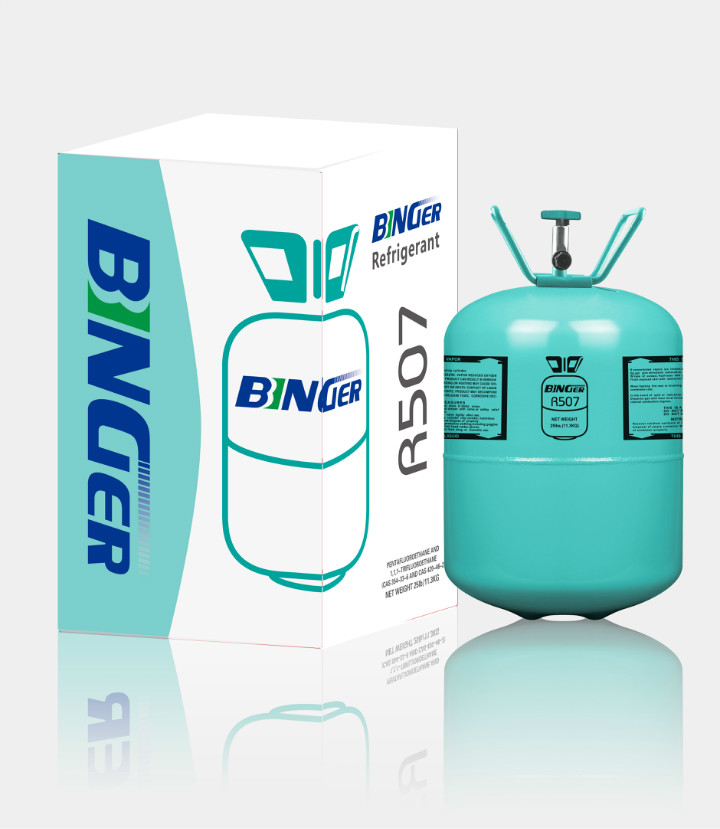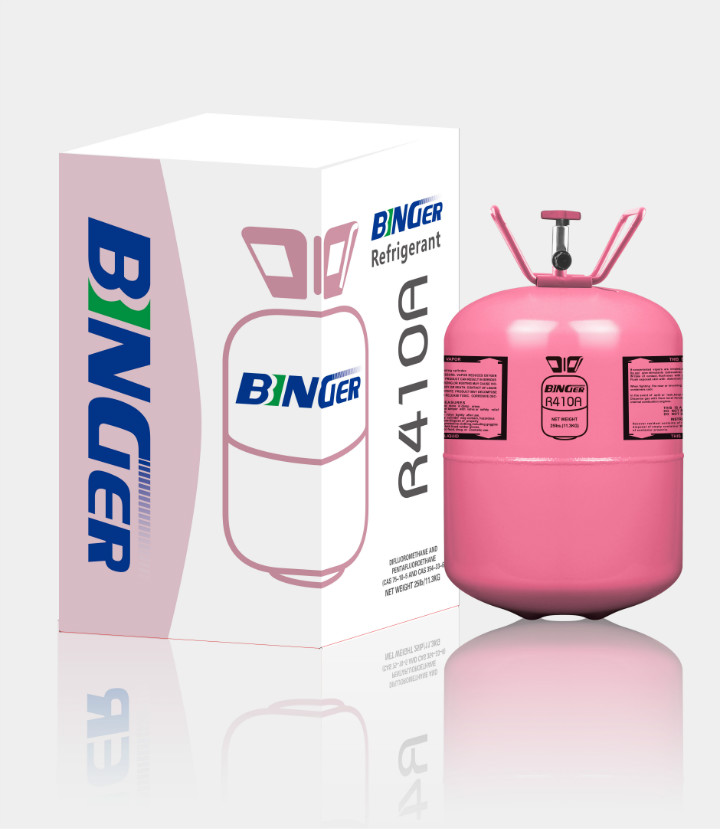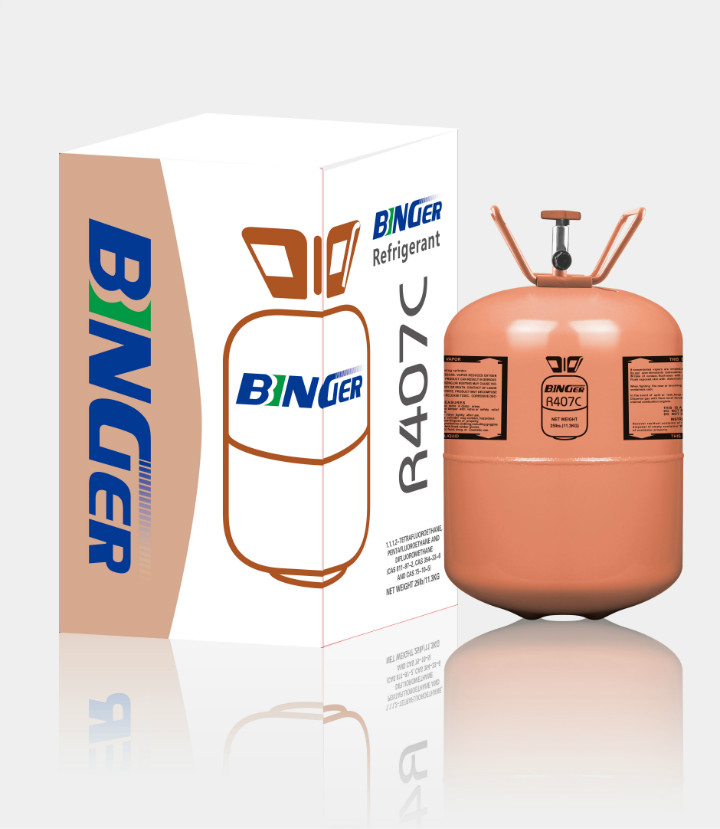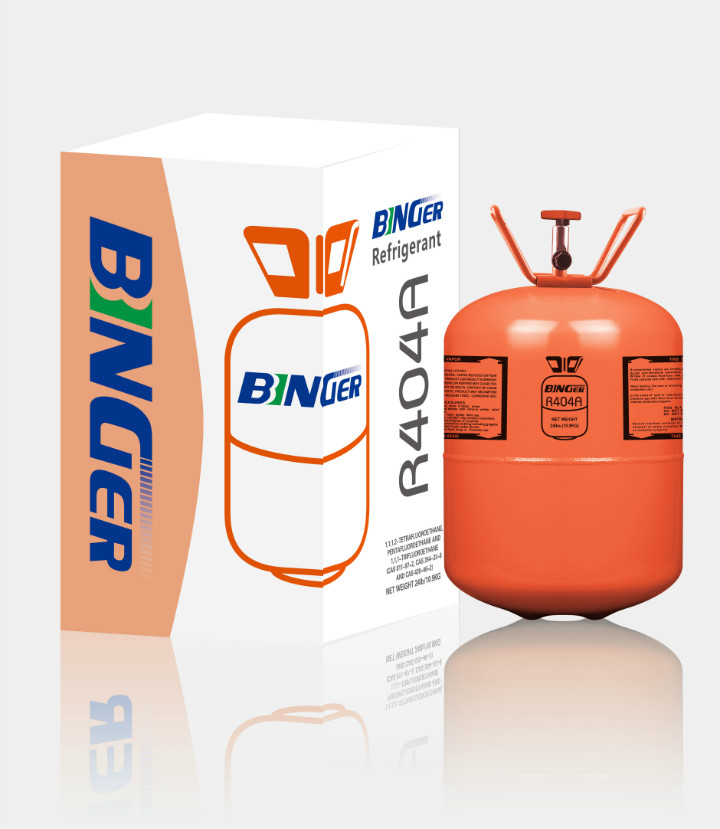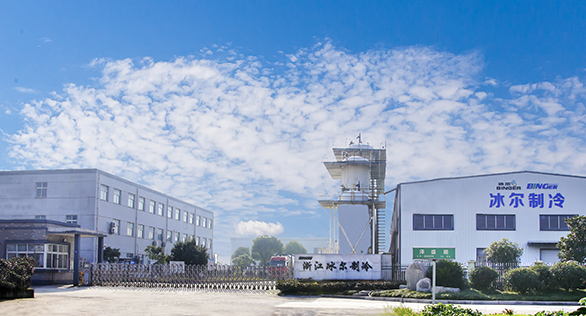Product Center
The company is professionally engaged in refrigerant R&D,manufacturing and distribution.
ABOUT BINGER
Zhejiang BingEr New Type Refrigerant Co.,Ltd. , located in Quzhou, Zhejiang Province of China,
was established in 2010, and covers an area of 19117 square meters.The company is professionally engaged in refrigerant R&D,manufacturing and distribution.
It focus on the R&D and extension of new-environment friendly refrigerant, and it has the ability to produce
single-quality and modern technology mixed refrigerants more than 10,000 tons
NEWS
2019-03-06
Congratulations on the successful revision of Zhejiang BingEr New Type Refrigerant Co.,Ltd. website!Congratulations on the successful revision of Zhejiang BingEr New Type Refrigerant Co.,Ltd. website!

-
2019-02-08
Juhua imported the filling equipment of American high-pressure aerosol refrigerant products
According to industry media news, juhua fluorine refrigerant business unit lianzhou company from the United States to introduce the high-pressure aerosol refrigerant product filling equipment is being adjusted, according to refrigeration express understand, this first domestic aerosol product high-pressure filling equipment, will double the filling capacity.
As JuHua brand automotive refrigerant aerosol products in the market share gradually expand, the United States company has become the current domestic leading automotive refrigerant R134a has a aerosol cans production and sales, the introduction of foreign advanced filling equipment, the company implemented "machine substitution", improve the production efficiency, seize the opportunity to speed up the aerosol products are exported to upsell the concrete measures of success putting-in-service proactively will increase aerosol products annual filling capacity of 4 million cans, aerosol rich variety and for the next step and to the development of high-end and prepare for the hardware. "This high-pressure refrigerant product filling line will provide guarantee for the filling of this series of aerosol products." This company official introduction.
The automatic production line has a high degree of automation, fast filling speed, the advantages of stable quality, complete automatic filling operation in a sealed condition, safety, no pollution, just 8 people, the whole production line filling process is equivalent to the original a 14 people operate 7 single manual control production line filling capacity, and avoid the manual equipment easily pressure tank damage problems before, will reduce the waste caused by frequent repair materials, low product cost control can achieve industry. -
2019-02-15
Why not buy cheap refrigeration?
In recent years, with the strength of enterprises and the improvement of customer requirements, more and more factories will choose the latter between price and quality when buying refrigeration equipment. But also have a factory to covet at that time cheap, and choose cheap, cheap can buy? Here's why you shouldn't buy cheap.
Buy cheap equipment
Only when you finish the price is happy! The chances are that none of them will be happy. Cheap things, its total cost is not necessarily low, but in other ways to save money to make up for it.
Buy quality
Give money that moment is love dearly! I feel happy every day when I use it, and it is worth it. Used for many years, the equipment has not how to maintain, is a small problem, manufacturers do very good after-sales.
3. Customers try their best to drive down prices and calculate costs
The client thinks our charge is expensive all the time, die all one's life bargained for price, calculate cost with me, I want to ask him very much: "design cost you calculate? Is the labor cost calculated? Are the marketing costs calculated? Does the company calculate its normal operating costs? Are the administrative costs calculated? Are the logistics costs calculated? Are storage costs calculated? ... "
Given a pile of steel, can you turn it into a refrigeration unit?
Given steel, can you build your own equipment? Give you a needle, can you do it yourself? Give you a basketball, you can play NBA? Given a bunch of materials, can you turn it into a refrigeration unit yourself?
The premise of service is profit
The premise of service is profit, every company should survive, profit can be reduced appropriately but cannot disappear, you take all the profit that ensures survival, the quality of refrigeration equipment, service after sale depends on who will safeguard.
6. The quality of products depends on your choice
It's expensive, yeah, it's expensive because it's good! Product quality, people in the taste! The quality of products depends on your choice! There is no such thing as the best product for the least amount of money.
7. Pursuit of perfection and quality first
Someone asked, "can you make your refrigeration cheaper?"
All I can say is, "I can't give you the price you want, but I can give you the quality you want. I'd rather explain the price for a while than apologize for the quality for a lifetime."
WeChat public account: zjbezl, bing er refrigeration look forward to your attention ~ -
2019-03-06
Can the refrigerant boom of 2019 last?
What are the reasons behind refrigerants going all the way up in 2018? What will the refrigerant market look like in 2019?
The high pressure environmental protection policy causes the material supply tight
R22 prices have been rising since the first half of 2018, with prices at high levels. The overall inventory of R32 market is low, domestic demand and export market demand remain stable, and the inventory of manufacturers has increased to a certain extent. The overall operating load of the device of R134a production enterprise remained stable. The supply of R410a market is relatively high, and most merchants keep purchasing on demand. R125 production enterprise device operating load in the upper level, generally maintain low inventory operation.
Many enterprises said that the refrigerant supply is still tight, the market supply is not enough, mainly because of environmental protection policies, resulting in a large number of enterprises had to cut production or production.
Why environmental protection will have a greater impact on refrigerant enterprises? Because a large number of fluoride refrigerants by-product during the production of hydrochloric acid, the byproduct hydrochloric acid treatment is difficult, usually as a low-end hydrochloric acid digestion, sold to the downstream enterprises such as reform of environmental regulation to strengthen and supply side factors, downstream enterprise starts falling by-product hydrochloric acid demand, refrigerant caused waste acid waste acid is difficult to handle, ZhangKu, companies are forced to reduce the work load caused by a lack of supply.
According to the data, the price of fluorite in 2018 surged 42.20%, from 2,555 yuan per ton at the beginning of the year to 3,633.33 yuan per ton at the end of the year, up as much as 42.20%. Fluorite prices hit a record high at the end of 2018, and the fluorine chemical industry is finally enjoying a busy sales season after years of recession. Take R22 as an example. It climbed from 89,000 tons in 2016 to around 23,000 tons.
In 2018, the price trend of hydrofluoric acid market was depressed at first and then increased. The price trend of hydrofluoric acid market was declining in the first half of the year, but the price of hydrofluoric acid market continued to rise in the second half of the year. In summary, the price of hydrofluoric acid was 12958.33 yuan/ton at the beginning of the year, and 14125 yuan/ton at the end of the year, with an annual increase of 9.00%. The highest price of the year appeared in 15475 yuan/ton on February 10, and the lowest price of the year appeared in 9116.67 yuan/ton on May 18, with the maximum amplitude of 41.09%.
At the same time, environmental protection as a double-edged sword, some of the scale, equipment, qualified enterprises ushered in the spring.
Rationed refrigerants are in short supply
According to the provisions of the Montreal agreement, the second generation of refrigerant will be completely eliminated, and according to the developed countries and developing countries made different elimination schedule: developed countries in 1996 began to freeze the consumption base, given a 24-year buffer period, will be completely eliminated in 2020 the use of the second generation; The process of elimination of developing countries is slightly slower than that of developed countries. Production and consumption must be frozen in 2013, cut from 2015, with a 17-year buffer period, and phased out entirely by 2030. Since 2013, China has implemented a quota policy for the consumption and production of the second-generation HCFCs refrigerant, which has been cut from 308,000 tons in 2013 to 274,000 tons in 2015. By 2020, there will be about 200,000 tons left, and by 2030, it will be completely eliminated.
Although the ODP value of the third-generation refrigerant is 0, it still has a high GWP value, which will greatly accelerate global warming and will be eliminated. On October 10, 2016, the 28th conference of the parties to the Montreal protocol adopted an amendment on HFCS reduction. According to the agreement, developed countries and developing countries have different economic development plans, and China has promised to gradually reduce the HFCs from 2024.
China, a major player in the Montreal protocol, will need to phase out ODS substances early. However, in recent years, while the demand of downstream air-conditioning enterprises has increased, the output of cold air conditioners in 2018 increased by 13.1% year-on-year. Sales increased by 13.5 percent year-on-year. Although the growth rate narrowed considerably compared with the cold year of 2017, it still maintained a double-digit growth rate. From the perspective of household air conditioners, the refrigerants are mainly R22, R32 and R410A. This year, due to the shortage of cooling oil for R410A and R32 air conditioners, the proportion of R22 models is relatively high. However, R22 is a product that has entered the phase-out period, and the quota supply will gradually increase the proportion of R32 and R410A. Third generation refrigerant is being used in great quantities again, cause third generation product unusual strain.
Where does 2019 stand: will refrigerant remain high
While refrigerants lead the way in 2018, how much longer can they continue? Relevant authorities pointed out that in 2019, environmental pressure is still high, fluorite, hydrofluoric acid and other raw materials prices will remain high. In addition, through the environmental protection management in recent years, non-compliant production enterprises were shut down or rectification, leaving the production of enterprises will be more standardized and stable. Moreover, R22 belongs to the HCFC refrigerant category, with the phase-out process, the quota will be reduced by another 25% by 2020; However, the HFC refrigerant phase-out policy takes 2020-2022 as the benchmark year, and the domestic production capacity of R32 and R125 will be doubled in 2019. -
2019-09-29
Warm congratulations on the 70th anniversary of the founding of the motherland!

-
2020-01-09
Influence of evaporation and condensation pressure on refrigeration system
When a failure occurs in a refrigeration system, it is generally impossible to see directly where the failure site occurs, nor is it possible to dissect and dissect the components of the refrigeration system one by one. Only by looking at the surface can abnormal phenomena be found in operation, for a comprehensive analysis. It is very important to measure the pressure and temperature of the refrigeration system.
1, Suction pressure and exhaust pressure: Refrigeration System in operation can be divided into high and low pressure two parts. Exhaust pressure refers to the exhaust pipe at the compressor outlet refrigerant gas pressure. The compressor suction pressure is called suction pressure, suction pressure close to the evaporation pressure. The difference between the two is the flow resistance of the pipeline.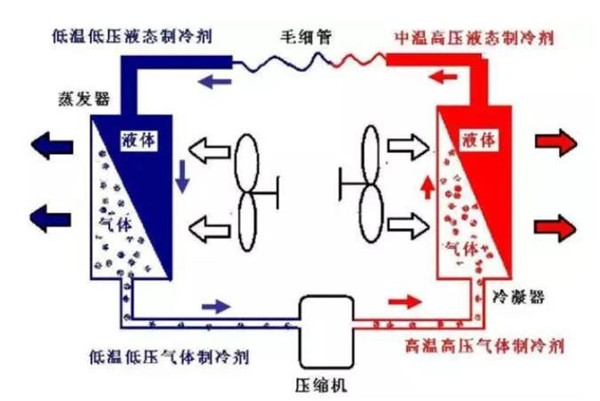
For convenience, the evaporating pressure and condensing pressure of the refrigeration system are detected at the suction and exhaust ports of the compressor. That is often called the compressor suction, exhaust pressure. The purpose of measuring the suction and exhaust pressure of refrigeration system is to obtain the evaporating temperature and condensing temperature of refrigeration system, so as to obtain the running status of refrigeration system.
2. Condensation pressure: Condensation pressure is the pressure at which the refrigerant condenses the gas into a liquid in the condenser. Since the pressure inside the condenser in the refrigeration system can not be measured, refrigerant in the exhaust pipe and condenser pressure drop is very small, so regardless of design commissioning or maintenance, generally think that the exhaust pressure is approximately equal to condensation pressure. Condensing temperature versus refrigerating capacity: Let's look briefly at the relationship between the condensing pressure of R22 refrigerant and the condensing temperature: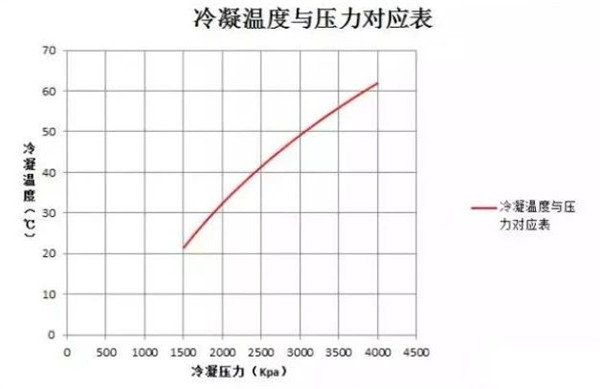
As can be seen from the diagram, the condensing temperature and condensing pressure are in direct proportion, the condensing pressure and condensing temperature are corresponding; the lower the condensing pressure (high pressure) , the lower the condensing temperature; the higher the condensing pressure (high pressure) , the higher the condensation temperature. Knowing the condensing pressure, we can look up the table and get the value of the condensing temperature. Heat load and condensation pressure relationship: This is simply the condensation side of the load and condensation pressure relationship. In a constant operating condition (refrigerant flow) , the greater the heat load, the higher the condensation pressure, and vice versa. We can imagine that when you design the condenser small (heat load is relatively large) , the refrigeration system is very easy to high-pressure alarm. The influence factor of refrigeration system pressure 1, the factor of low suction pressure: The suctionpressure is lower than the normal value, the factors include insufficient refrigeration capacity, small cooling load, small expansion valve opening degree, low condensing pressure (refers to the capillary system) , and the filter isn't working. High Suction pressure factors: Suction pressure higher than normal, its factors are too much refrigerant, refrigeration load, expansion valve opening, high condensation pressure (capillary system) and compressor efficiency. 2, exhaust pressure, high exhaust pressure factors: When the exhaust pressure is higher than the normal value, there is generally a cooling medium of low flow or high temperature, refrigerant charge too much, large cooling load and expansion valve open degree. These results result in the increase of circulating flow and the corresponding increase of condensation heat load. As the heat can not be all out in time, causing condensation temperature rise, and can be detected is the exhaust (condensation) pressure rise. When the flow rate of the cooling medium is low or the temperature of the cooling medium is high, the cooling efficiency of the condenser decreases and the condensing temperature increases. When the flow rate of the cooling medium is low or the temperature of the cooling medium is high, the cooling efficiency of the condenser decreases and the condensing temperature increases. The reason of excessive refrigerant charge is that the surplus refrigerant liquid occupies part of the condenser tube, which reduces the condensing area and causes the condensing temperature to rise. Factors of low exhaust pressure: The exhaust pressure is lower than the normal value. The factors include low efficiency of the compressor, insufficient refrigerants, small cooling load, small expansion valve opening, unblocked filter, including expansion valve filter screen and cooling medium temperature low. Above several kinds of factors all can cause the system the refrigeration flow to drop, the condensation load is small, causes the condensation temperature to drop. From the above suction pressure and exhaust pressure and exhaust pressure changes, there is a close relationship between the two. In general, when the suction pressure rises, the exhaust pressure rises, and when the suction pressure drops, the exhaust pressure drops. Also may estimate from the suction pressure gauge change the exhaust pressure approximate situation.
Warm and cold life, Binger company!
-
2020-01-10
Fault analysis of compressor liquid strike
The phenomenon that liquid refrigerants and / or lubricants in the Refrigeration System Damage the suction valve plate when they are sucked into the cylinder of the compressor, and they are not discharged rapidly after entering the cylinder, the phenomenon of transient high hydraulic pressure produced by the compression of a Piston near TDC is often referred to as a hydraulic blow. Hydraulic blow can cause damage to compressed components such as valves, Pistons, connecting rods, crankshafts, Piston pins, etc. in a short period of time and is a deadly Reciprocating compressor. The occurrence of a liquid strike can be prevented by reducing or preventing the liquid from entering the cylinder, so the liquid strike can be completely avoided.
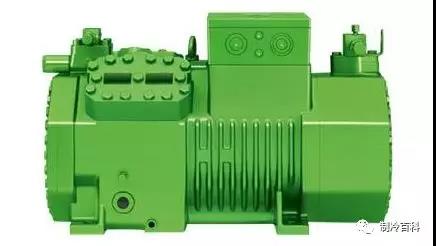
Usually, fluid percussion can be divided into two parts or processes:
• first, when more liquid refrigerants, lubricants, or a mixture of both enter the compressor cylinder at a higher speed with suction, due to the impact and incompressibility of the liquid, it can cause excessive bending or fracture of the Suction Valve Plate;
secondly, when the liquid in the cylinder which has not been evaporated and discharged in time is compressed by the Piston, the huge pressure appears in an instant and causes the deformation and damage of the stressed parts. These forces include Suction and Exhaust Valve Plate, Valve Plate, valve plate gasket, Piston (top) , Piston Pin, connecting Rod, crankshaft, bearing, and so on.
The process and phenomenon of refrigeration compressor liquid strike
Suction Valve piece broken: The compressor is a compressed gas machine. Typically, the Piston compresses the gas 1,450 times per minute (for a semi-hermetic compressor) or 2,900 times per minute (for a fully hermetic compressor) , that is, it takes 0.02 seconds or less to complete an intake or exhaust process. The size of the suction and exhaust holes on the Valve Plate and the elasticity and strength of the Suction and exhaust valve plates are designed according to the flow of gas. From the point of view of the force on the Valve Plate, the impact force produced by the gas flow is relatively uniform.
A liquid is tens or even hundreds of times as dense as a gas, so it flows with much more momentum than a gas and produces much more impact. The flow in the cylinder with more droplets in the suction is two-phase flow. The impact of two-phase flow on the suction valve plate is not only strong but also high frequency, just like a typhoon with pebbles hitting on the glass window, its destructiveness is self-evident. The fracture of suction valve is one of the typical characteristics and process of fluid percussion.
Refrigeration compressor connecting Rod Fracture: compression stroke time of about 0.02 seconds, and the exhaust process will be shorter. Droplets or liquid in the cylinder must be discharged from the vent in such a short time, and the speed and momentum are great. The situation of the exhaust valve piece is the same as that of the suction valve piece. The difference is that the exhaust valve piece is not easily broken because of the limited position plate and the spring plate support. When the impact is serious, the limit plate will also be warped.
If the liquid does not evaporate and leave the cylinder in time, the Piston compresses the liquid near TDC, which, because of its short duration, appears to be an impact, and a metallic knock is heard in the cylinder head. The compressed liquid is another part or process of the fluid percussion phenomenon.
The high pressure produced in the moment of liquid impact is very destructive. Besides the bending and even breaking of the connecting Rod, other compression force components (Valve Plate, Valve Plate Pad, crankshaft, Piston, Piston Pin, etc.) will also be deformed or damaged, but they are often neglected, or it could be confused with excessive exhaust pressure. It is easy to find bent or broken connecting rods and replace them without checking other parts for deformation or damage, thus laying the foundation for future failures.
The fracture of the connecting Rod caused by the hydraulic blow is distinguishable from that caused by the holding of the axle and the Piston biting the cylinder. First of all, the connecting rod bending or breaking caused by hydraulic impact in a short period of time, the Piston and crankshaft at both ends of the connecting rod move freely, generally there will not be serious wear and tear caused by holding the shaft or biting the cylinder. Although the Broken Suction Valve fragment occasionally causes severe scratches on the Piston and cylinder surfaces, surface scratches are quite different from lubrication failures that cause wear.
Secondly, the break of connecting Rod caused by hydraulic impact is caused by pressure. Connecting Rod and stubble have extrusion characteristics. Although the connecting Rod may break after the Piston Bites the cylinder, the Piston must be stuck in the cylinder. After holding the connecting rod broken is even more different, connecting rod big head and crankshaft have serious wear and tear, causing the breaking force belongs to the Shear Force, stubble is not the same. Finally, before holding the axle and biting the cylinder, the motor will operate over-load, the motor will heat seriously, and the thermal protector will act.
Second, the liquid source obviously, can cause the compressor to hit the liquid is nothing more than the following sources:
Obviously, the liquid that can cause compressor fluid to hit is nothing more than the following sources:
• return liquid, which is liquid refrigerant or lubricant returned to the compressor from the evaporator;
• Foam when starting with liquid;
• too much lubricant in the compressor.
Article collation comes from "Refrigeration Encyclopedia" ,
Cold and warm life binger accompanied -
2020-03-18
Operating parameters of air conditioning water system and refrigeration system
Unit Working Power Supply Unit working power supply is 380V / 50Hz / 3n, its fluctuation range is between 360V ~ 420V. However, the operation of the unit has strict requirements on power supply: Power supply three-phase voltage imbalance should not be greater than 2, power supply three-phase current imbalance should not be greater than 10. Voltage is too high or too low, will cause the unit motor running current is too large, serious will burn out the unit motor.
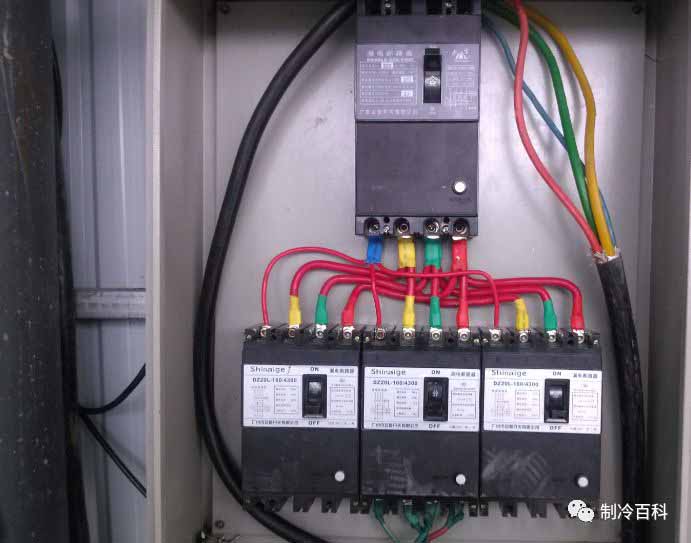
Three-phase voltage unbalance calculation method: For example, the unit rated voltage is 380V, the measured three-phase voltage is: A-B 386V; A-C 385; B-C 382V; namely 386-3806,385-3805,382-3802. Three-phase voltage imbalance 63801001.6, that is normal (three-phase current imbalance calculation method is the same) . 2. The operating parameters of circulating water system should check the pressure difference between the inlet and outlet of chilled water and cooling water before starting up, which should be between 0.08 MPA and 0.15 MPA. If the inlet pressure is 0.4 MPA, the outlet pressure should be between 0.32 MPA and 0.25 MPA. The pressure difference is too small, that unit water flow is not enough, at this time, we should check whether the pump is working properly, whether the valve is open normally, whether the water system has air, whether the water system filter (y grid) is blocked, etc. . Do not turn on the machine until the water supply is confirmed to be normal. If the water supply is not normal, the unit will not be long after the start-up "low evaporation temperature" alarm and protective shutdown. During the normal operation of the unit, we should pay attention to the temperature difference between the inlet and outlet of the chilled water and the cooling water, which should be between 3 °C and 5 °C. If the temperature of the frozen water inlet is 15 °C, the temperature of its outlet water should be between 12 °C and 10 °C. If the temperature difference is too small, the heat exchange effect of the heat exchanger of the unit is poor. At this time, we should check whether the water quality is normal, whether the heat exchange pipe is dirty and dirty, and so on, we should check whether the normal operation of the pump, the opening of the valve is normal, whether the water system has air, water system on the filter (y grid) is blocked, etc. . Time is not long the unit will be "low evaporation temperature" alarm and protective shutdown. We should pay attention to observe the difference between the outlet temperature of chilled water and cooling water and the refrigerant temperature of evaporator and condenser should not be more than 2.5 °C. If the outlet temperature of the freezing water is 10 °C, the outlet temperature of the evaporator should be between 8 °C and 10 °C, and the outlet temperature of the cooling water should be between 30 °C and the outlet temperature of the condenser should be between 28 °C and 30 °C. The smaller the temperature difference is, the better the heat exchange effect of the unit heat exchanger is. The larger the temperature difference is, the worse the heat exchange effect of the unit heat exchanger is.
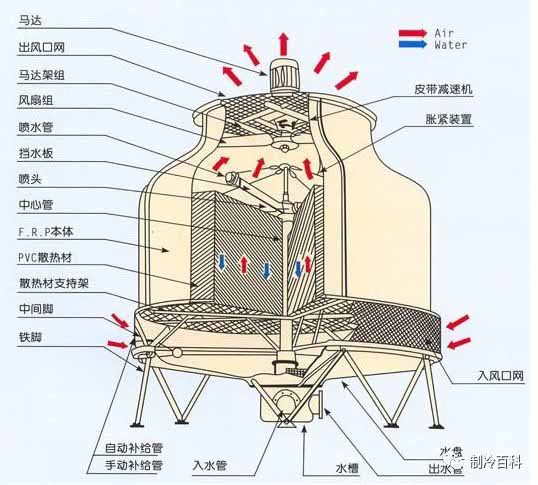
We should pay attention to observe the temperature difference between the inlet and outlet water of the Cooling Tower, which should be between 3 °C and 5 °C. If the inlet water temperature of the cooling tower is 30 °C, the outlet water temperature of the cooling tower should be between 25 °C and 27 °C. The temperature difference is too small, that the cooling tower cooling effect is poor. In another case, when the inlet temperature of the cooling tower is higher than the ambient temperature, the difference between the ambient temperature and the outlet temperature of the cooling tower should not be more than 3 °C. If the ambient temperature is 34 °C and the inlet water temperature of the cooling tower is 37 °C, the outlet water temperature of the cooling tower is about 34 °C. At this time, higher than our unit normal operating temperature requirements, we do not think that the cooling tower cooling effect is not good, in fact, this is normal. Because the cooling tower itself does not have the function of cooling, it is only the auxiliary cooling water to the environment space, so the water temperature of the cooling tower is close to the environment temperature, it should be the best working state of the cooling tower. Three, refrigeration system's main parameter refrigeration system's debugging is adjusts the system operation parameter to the request scope. The main parameters of refrigeration system are: evaporating temperature and pressure; condensing temperature and condensing pressure; compressor suction and exhaust temperature; compressor suction and exhaust pressure; oil temperature; oil filter pressure difference. These operating parameters are not fixed, but change with the change of the external conditions. Therefore, when the refrigeration unit is debugged, the operating parameters must be adjusted according to the external conditions and the characteristics of the unit so that they can operate under reasonable, economical and safe values. Evaporation temperature and pressure the evaporation temperature and pressure are determined according to the user's requirements. The evaporating temperature of the unit should be determined according to the temperature requirement and working characteristics of the cooling medium. For the refrigeration capacity of the compressor, when the condensing temperature is fixed, the lower the evaporating temperature, the smaller the refrigeration capacity, due to insufficient cooling capacity, so that the cooling medium temperature can not be reduced. While the temperature difference is smaller, the heat transfer effect is poor, although the compressor cooling capacity increases, but the evaporator heat exchange is not sufficient. Therefore, we should choose the temperature difference reasonably according to the different forms of refrigeration equipment. According to the standard of JB / T4329-97 volumetric cold water (heat pump) units in China, the nominal working conditions of chillers are cold water inlet temperature 12 °C, outlet water temperature 7 °C, cooling water inlet temperature 30 °C and outlet water temperature 35 °C.
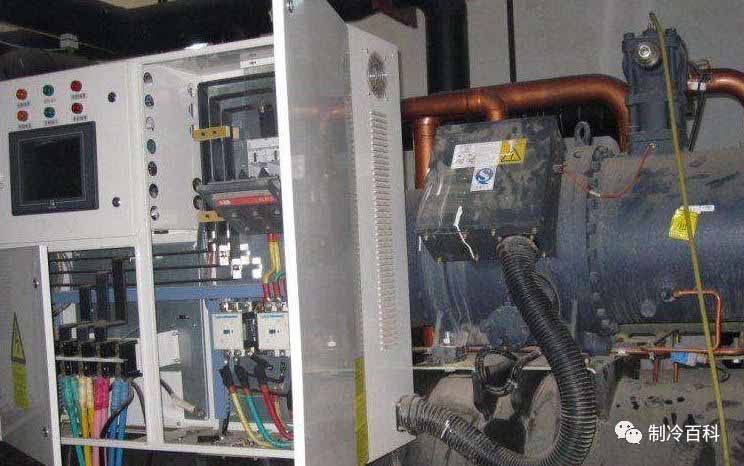
As a result of increasing the temperature of the cold water out of the unit is very beneficial to the economy. In operation, the temperature of cold water should be raised as much as possible when the requirement of air conditioning is met. If the cold water outlet temperature is not 7 °C for long term operation, the required cold water outlet temperature should be specified in the contract. Therefore, in the actual operation of the unit, according to the specific requirements of the air-conditioning object, the cold water temperature can be raised or appropriately lowered. In general, the evaporation temperature is 2 ~ 4 °C lower than the cold water outlet temperature, then the evaporation temperature is controlled in the range of 3 ~ 5 °C. For evaporators with cooled liquid medium, the evaporating temperature should be 4 ~ 6 °C lower than that of the cooled liquid medium. The difference between the evaporating temperature and the temperature of the cooling medium is actually the opening of the throttle valve. At present, there are commonly used throttle manual throttle, thermal expansion valve, constant pressure expansion valve, float ball valve, etc. . When we debug and run, we mainly observe the change of evaporation pressure to judge whether the expansion valve opening is suitable. If the valve opening is too small and the liquid supply is insufficient, the evaporating pressure and temperature will drop, the compressor will draw in too hot, the exhaust temperature will also rise, and if the liquid supply is too much, the evaporating pressure and temperature will both rise, and the excessive liquid, it will also cause the compressor to have the liquid strike accident. Therefore, it is one of the main methods to control the evaporation temperature and pressure in operation to control the opening degree of the throttle valve correctly. In addition, if the heat exchange area of the evaporator is too small or if there is dirt on the inner and outer surfaces, the evaporation temperature will be reduced when the cooling load and the capacity of the compressor are not changed, then the evaporating temperature 2, condensing temperature and condensing pressure of the refrigeration system are the pressure indicated by the high-pressure gauge. Under normal circumstances, the condensing temperature is 5-7 °c higher than the inlet temperature of the cooling water, it is 10 ~ 15 °c higher than the inlet temperature of cooling air with forced ventilation. When the evaporating temperature is constant, the condensing temperature and pressure increase, the compressor compression ratio increases, the gas transmission coefficient decreases, the refrigeration capacity of the compressor decreases, but the power consumption increases. In addition, the condensation pressure increases, the compression exhaust temperature increases. If the exhaust temperature is too high, it will dilute the compressor lubricating oil and affect the lubrication. When the exhaust temperature is close to the lubricating oil valve point, some lubricating oil will be carbonized and accumulate in the exhaust valve, which will affect the sealing performance of the valve, on the valve plate, end cover spring and so on have an impact. During the operation, the heat transfer resistance is increased and the refrigerant vapor can not be condensed in time because of the non-condensable gas such as oil film, scale on the inner surface of the condenser or a little air in the system. The general treatment method is to regularly drain oil, air and according to the water quality of regular cleaning scale. There are two ways to clean and remove the scale and reduce the condensing temperature: to reduce the water temperature of the condenser cooling water and to increase the cooling water. 3. The suction temperature and suction pressure of the compressor suction temperature is high, the exhaust temperature is also high, the specific volume of the refrigerant when it is inhaled is large, when the refrigeration capacity per unit volume of the compressor is reduced; on the contrary, when the suction temperature of the compressor is low, the refrigeration capacity per unit volume is large. But the compressor suction temperature is too low, may cause the refrigerant liquid was sucked into the compressor, so that the Reciprocating compressor produced a liquid hit phenomenon. In addition, the length of the compressor suction pipe and wrapped insulation material performance, the size of the superheat, but also have a certain impact. The suction temperature is generally controlled at 5 ~ 10 °C in the refrigerating unit, and 15 °C in the freon system with the regenerative heat exchanger. Therefore, in the operation of the machine, we must pay attention to the control of the suction temperature of the compressor, usually with the adjustment of the thermal expansion valve screw to adjust the size of the overheating. 4, compressor exhaust temperature and pressure compressor exhaust temperature is the refrigerant after compression of high-pressure superheated steam. Because the refrigerant discharged by the compressor is superheated steam, there is no corresponding relationship between its pressure and temperature. The exhaust temperature of the compressor can be read from the thermometer on the exhaust pipe. The exhaust pressure is generally slightly higher than the condensation pressure and the exhaust temperature is much higher than the condensation temperature. The exhaust temperature is mainly related to the suction temperature, pressure and pressure ratio, and increases with the increase of them. Condensing temperature and exhaust temperature are too high on the operation of the compressor is unfavorable, should be prevented. 5. The normal oil temperature of oil temperature unit is between 45 °C and 68 °C. If the oil temperature is too low, a large number of refrigerant will dissolve in the oil, will cause the unit to return oil difficult, a large number of oil in the evaporator and condenser, affect the heat transfer effect. At this point we have to adjust the oil cooler supply (water) valve to maintain the appropriate oil temperature. If the oil temperature is too high, it will reduce the viscosity of the oil, lose its lubricating effect and shorten the service life of the spare parts of the unit. At this point, we want to check whether the oil cooler supply (water) valve open normal or oil cooler supply (water) pipeline is blocked, for removal. 6, oil filter pressure difference should be less than 50 PISD. If the pressure difference is greater than 50Pisd, the unit will be "oil filter blockage" alarm and protective shutdown. It indicates that the oil filter of the unit is saturated or dirty. At this point, we need to replace the oil filter, to ensure that the normal oil supply unit.
Article Collation from the "encyclopedia of refrigeration"
cold and warm life, binger accompanied! -
2020-04-01
Analysis of operation parameters and working condition of water chiller
1.Evaporation pressure and evaporation temperature, in the operation of chillers, evaporation temperature, evaporation pressure and cold water into the heat evaporator is closely related. When the heat load is large, the return water temperature of the cold water of the evaporator rises, which causes the temperature of the evaporator to rise and the corresponding evaporation pressure to rise. On the contrary, when the heat load is reduced, the return water temperature of cold water decreases, and its evaporation temperature and evaporation pressure both decrease. When the heat load of the air-conditioned room is reduced, the return water temperature of the cold water decreases, and the evaporation temperature and evaporation pressure are evenly distributed. According to the standard of JB / T3355 -- 1998, the rated working condition of chiller is 7 °C of chilled water outlet temperature and 30 °C of cooling water return temperature. The other corresponding parameters are the return water temperature of freezing water 12 °C, and the outlet water of cooling water 35°C.
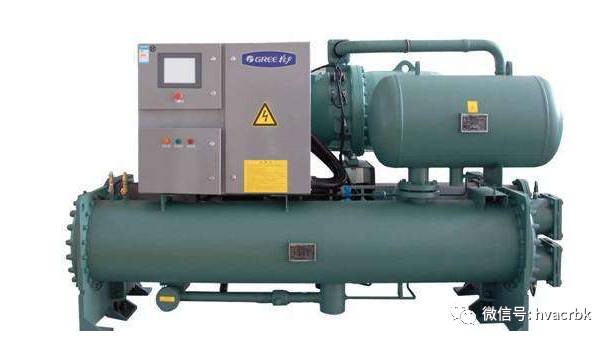
2.According to the National Standard GB / T18403.1 -- 2001, the rated working conditions of chillers are chilled water inlet and outlet temperature 12 °C / 7 °C and cooling water inlet and outlet temperature 30 °C / 35 °C. Therefore, when the chiller leaves the factory, the working conditions are the inlet and outlet temperature of the chilled water 12 °C / 7 °C and the inlet and outlet temperature of the cooling water 30 °C / 35 °C. In operation, the temperature of cold water should be raised as much as possible when the requirement of air conditioning is met. In general, the evaporation temperature is 2 °C ~ 4 °C lower than the cold water outlet temperature. The evaporation temperature is usually controlled in the range of 3 °C ~ 5 °C. Too high evaporating temperature is difficult to achieve the required air conditioning effect, and too low evaporating temperature, not only increases the unit's energy consumption, but also easy to cause the evaporating pipeline freeze crack.
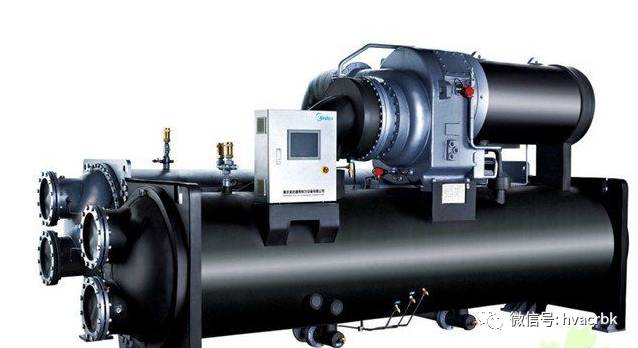
3.Condensation pressure and condensation temperature in a chiller, the pressure indicated by a high-pressure gauge is called condensation pressure, and the temperature corresponding to the pressure is called condensation temperature. The condensing temperature is of great importance to the power consumption of the unit under the condition of constant evaporating temperature. In addition, the increase of the condensing pressure of the centrifugal refrigeration unit will cause the surge of the main engine. On the contrary, the power consumption decreases with the reduction of condensation temperature. Therefore, in the operation of chillers, attention should be paid to ensure that the cooling water temperature, water quantity, water quality and other indicators in the eligible range. When the air is in the condenser, the temperature difference between the condensing temperature and the cooling water outlet increases, while the temperature difference between the cooling water inlet and outlet decreases. In addition, scaling and sludge on the water side of condenser tubes also play an important role in heat transfer. 3. Pressure and temperature of cold water chillers for air conditioning generally operate under the conditions of 12 °C of cold water return water temperature, 7 °C of water supply temperature and 5 °C of temperature difference stipulated in the standard working conditions. The cold water flow rate of the evaporator is inversely proportional to the temperature difference between supply and return water, that is, the larger the cold water flow rate, the smaller the temperature difference;. Therefore, the operating condition of the chiller sets the temperature difference between the cold water supply and return water as 5 °C, which in fact sets the cold water flow rate of the chiller. This control of the flow of cold water on the performance of the control of cold water through the evaporator too much pressure drop. The pressure drop of cold water supply and return water on the evaporator is set to 0.5 KGF / CM2 under standard operating conditions. The pressure drop adjustment method is to adjust the cold pump outlet valve opening, and evaporator supply, backwater valve opening.
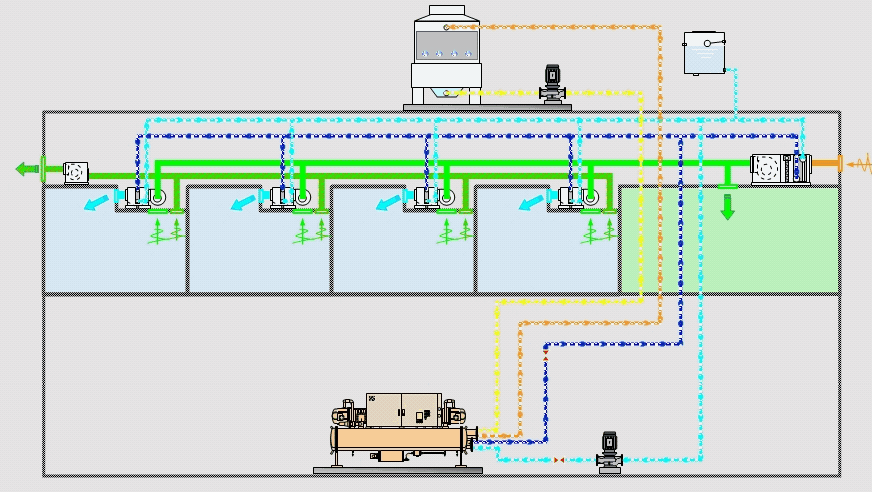
4.The pressure and temperature of cooling water chillers run under standard operating conditions, the return water temperature of the condenser is 30 °C and the outlet temperature is 35 °C. For Water chillers in operation, environmental conditions, loads and refrigerating capacity have been established. At this point, the condensation heat load is no doubt constant. The standard stipulation enters, the water temperature difference is 5 °c, the cooling water flow must also be certain value. And the flow is inversely proportional to the difference in temperature between the incoming and outgoing water. Therefore, chillers in standard operating conditions, as long as the provision of cooling water into and out of the water temperature difference on the line. This flow is usually controlled by the pressure drop of cooling water in and out of the condenser. Under standard operating conditions, the outlet pressure drop of the condenser is set at about 0.75 KGF / CM2. Pressure drop adjustment method is also used to adjust the cooling water pump outlet valve opening and condenser inlet and outlet valve opening. In order to reduce the power consumption of water chiller, the condenser temperature should be as low as possible. It can take two measures: reducing the return water temperature of the condenser and increasing the cooling water. For Centrifugal chillers, too high or too low condensation pressure will cause surge. Centrifugal chillers encountered in this case, should pay attention to the condensation pressure and evaporation pressure difference can not be too small, should meet the need to prevent the occurrence of surge, otherwise there will be surge. In the autumn when the temperature is low, it is advantageous to run the reciprocating chillers because the condensing pressure is low and the power consumption is greatly reduced.
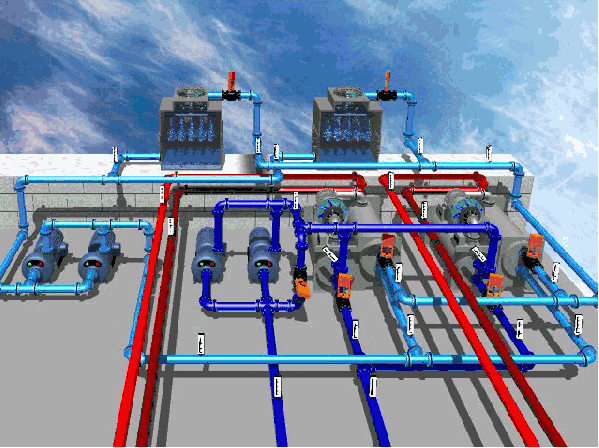
5.Compressor suction temperature the suction temperature of a compressor, for Reciprocating compressor, is the temperature of refrigerant gas in the Suction Chamber of the compressor; for Centrifugal compressors, it is the temperature of refrigerant gas on the Suction Guide vanes. The suction temperature not only affects the exhaust temperature, but also has an important impact on the volumetric refrigeration capacity of the compressor. When the compressor suction temperature is high, the exhaust temperature is high, the refrigerant is inhaled when the specific volume, when the compressor unit volume refrigeration capacity is small, this is what we do not want. In contrast, the compressor suction temperature is low, its unit volume refrigeration capacity is large. However, the compressor suction temperature is low, may result in refrigerant liquid was divided compressor suction, so that the Reciprocating compressor "liquid shock" . And for centrifugal compressor, because of too low suction temperature so that the compressor suction pressure is too low, may produce surge. Therefore, to provide for the compressor suction superheat. For reciprocating chillers, the compressor suction superheat for 5 ~ 10 °C, when the use of dry evaporator. The degree of superheat can be controlled by a thermal expansion valve, and the degree of superheat can be adjusted by adjusting the adjusting screw rod of the thermal expansion valve. 6. The exhaust temperature of the compressor is much higher than the condensing temperature, the direct influence factor of the exhaust temperature is the suction temperature of the compressor, the two are proportional. If the Reciprocating compressor suction, exhaust valve plate is not tight or broken leakage (internal leakage) , the exhaust temperature will rise significantly. In the centrifugal refrigeration unit, if the refrigeration system mixed with air, the suction temperature and exhaust temperature will increase. The middle pressure and temperature of the chiller is called the economizer, and the pressure inside the economizer is the middle pressure of the chiller, the refrigerant temperature is the intermediate temperature and the intermediate pressure is determined by the principle that the total power consumption of the low-pressure and high-pressure stage compressors of the two-stage centrifugal refrigeration compressor is as small as possible and the circulating refrigeration system is as large as possible. 8. Oil pressure difference, oil temperature and oil level high lubricating oil system is an indispensable part of the normal operation of the unit, which provides lubrication and cooling conditions for the moving parts of the unit. The oil pressure difference, oil temperature and oil pressure height are the three essential factors to ensure the lubrication and cooling of moving parts under normal working conditions. The ROLE OF OIL PRESSURE DIFFERENCE: is to make the oil in the oil pump drive, in the oil system pipeline flow, transport to the working parts to overcome its flow resistance. Oil Temperature: The oil temperature has an important influence on the viscosity of lubricating oil. Low Oil temperature will increase the oil viscosity, liquidity, not easy to form a uniform oil film, can not achieve the desired lubrication effect. Oil Level: The oil level is too low easy to cause the unit operation failure or damage accident. REFERENCE FOR CONTROL RANGE OF OIL PRESSURE DIFFERENCE: Reciprocating unit is 1.5 ~ 3.0 KGF / CM2; twin screw unit is 1.5 ~ 12.5 KGF / CM2; Centrifugal unit is 1.5 ~ 2.5 KGF / CM2. 9. Unit operating current and voltage the rated supply voltage required by general unit is 380V, three-phase, 50Hz, the average phase voltage instability rate is less than 2% . The operating voltage of all motors shall be within 5% of the voltage specified on the compressor nameplate.
Article Collation from the "encyclopedia of refrigeration"
cold and warm life, Binger accompanied -
2020-04-21
Commercial Air conditioning compressor replacement reference
Commercial Air conditioning compressor replacement reference
step 1: Cut off the power supply, confirm the compressor damage needs to be replaced, first disconnect the outdoor machine power supply switch, disconnect the power supply wiring, disconnect the outdoor unit from the power supply and seal it with an insulating tape.


step 2: Clean the electrical box components. When removing the compressor wiring, the temperature sensor and the electric heating, the corresponding marks should be made to facilitate the rewiring after replacement.
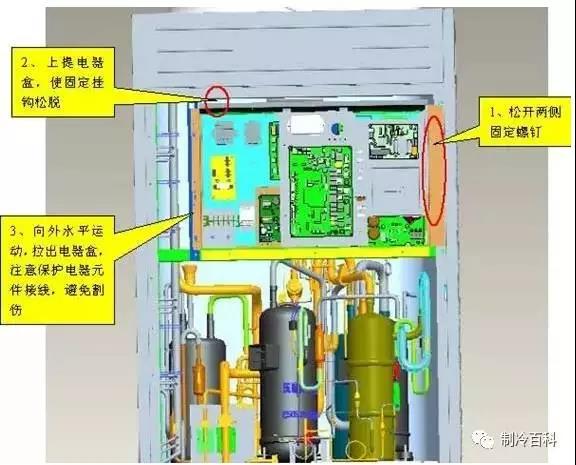
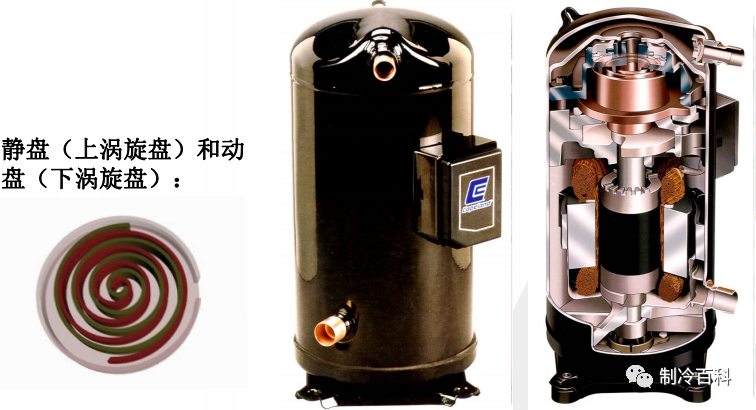
step 3: Release the refrigerant, the refrigerant of the system, should be released from both the high and low pressure sides of the system. If the air is released from only one side, the scroll seal will result in incomplete refrigerant release. Do not release the refrigerant too quickly, or a large amount of lubricant will be taken out of the system together with the refrigerant.
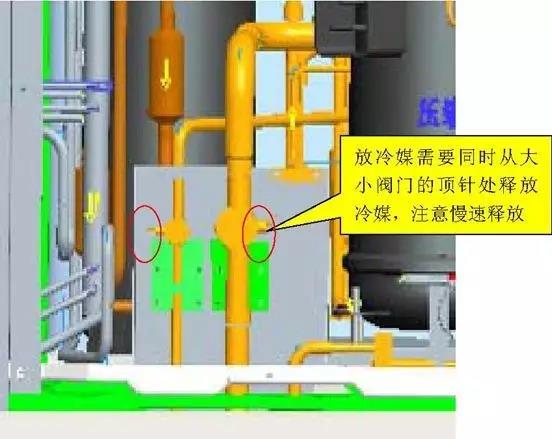
step 4: When the compressor is replaced and the compressor is dismantled to confirm the oil quality, if the oil quality is clear and no impurities are found, the oil quality in the system can be considered not contaminated, while ensuring that the unit valves and oil circuits are not abnormal, you can just replace the compressor.
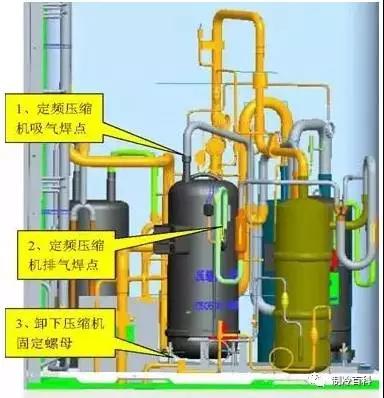
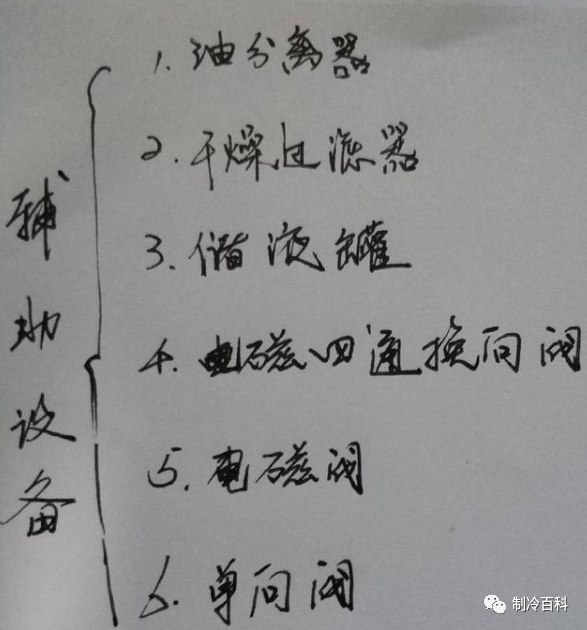
1.Remove the compressor, the compressor in the solid ground shaking, shaking angle should be between 30 ~ 45 degrees (left) , to ensure that the deposition in the bottom of the compressor can be poured out.
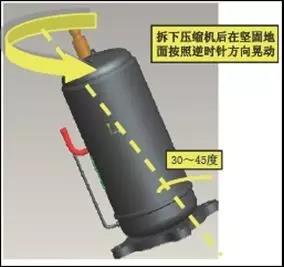
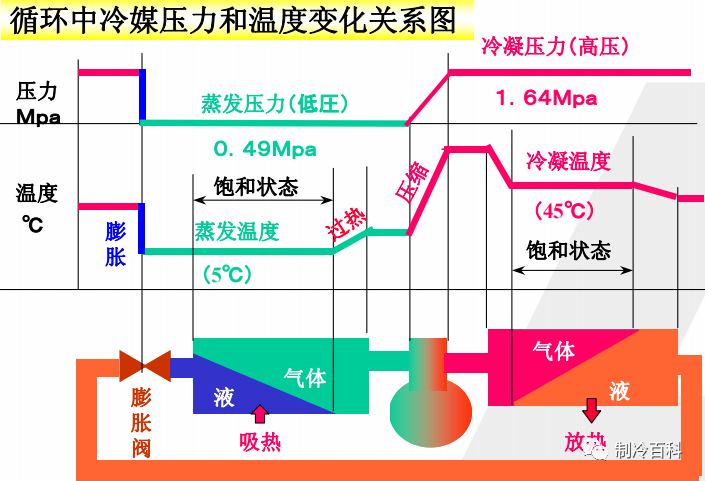
2.Place the compressor above the level of the ground. Pour oil from the compressor outlet. Use a beverage bottle or other transparent container to store the oil. The amount of oil collected should be greater than 150 ml. Note that the compressor axial position and horizontal angle should not exceed 20 degrees.\
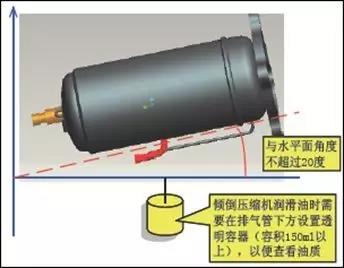
3.Put the collected compressor oil in a bright place to see if it contains impurities and discoloration. Also note the smell of the compressor oil. The normal oil has no obvious pungent smell.
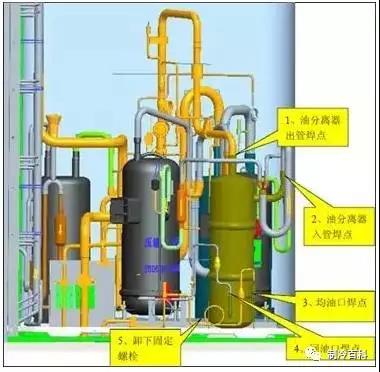
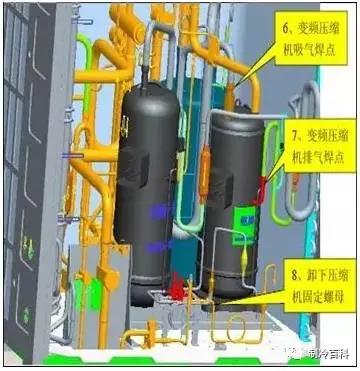
step 5: Confirm the system components, system oil pollution, you need to confirm the unit's components, including the oil separator, gas-liquid separator and storage tank.
1.(oil separation, below) , confirm that there are no impurities, etc. .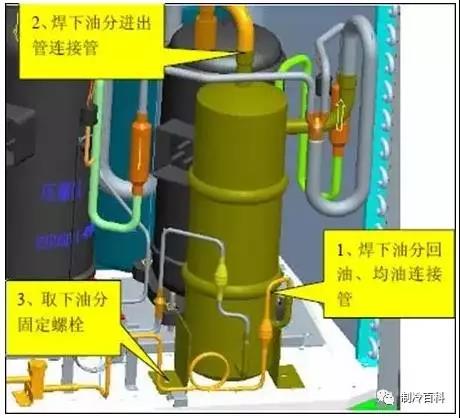
2, gas-liquid separator (below) , check whether there are impurities and other substances.
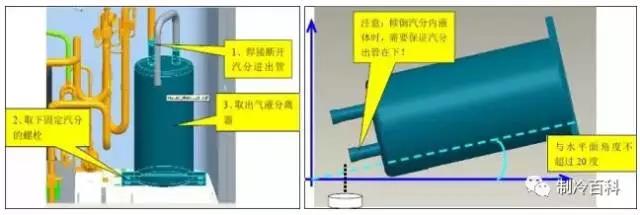
Note: If the compressor damage needs to be replaced, must also replace the gas-liquid separator! Whether or not the gas-liquid separator contains impurities or other abnormal conditions.
3. Remove the tank (below) to confirm that it does not contain any impurities.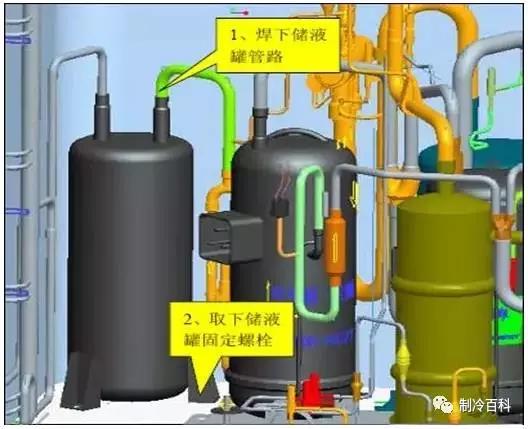
Note: to collect the oil, gas, liquid tank poured out of the compressor oil, and make a good record, to facilitate the replacement of compressor, gas, and other components, the system to add lubricating oil.
Step 6: After cleaning the system and identifying the parts that need to be replaced, make sure that there is no abnormality in the system piping, use nitrogen to blow-wash the main piping, and focus on testing and cleaning the oil piping system.
1.Clean all oil pipeline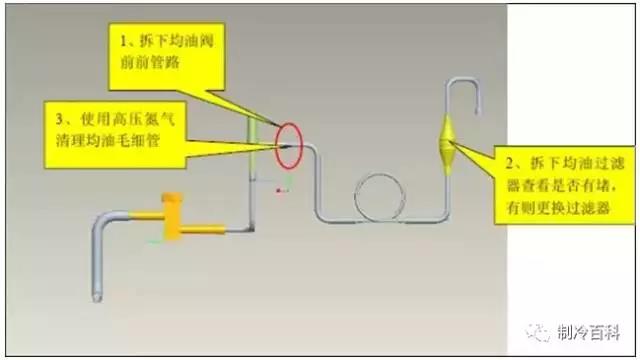
2, CLEAN RETURN OIL PIPELINE
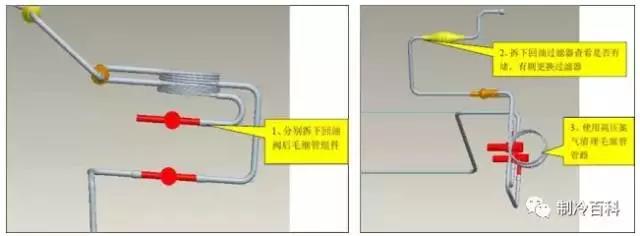
step 7: Check before replacement, check whether the model of the compressor is consistent.
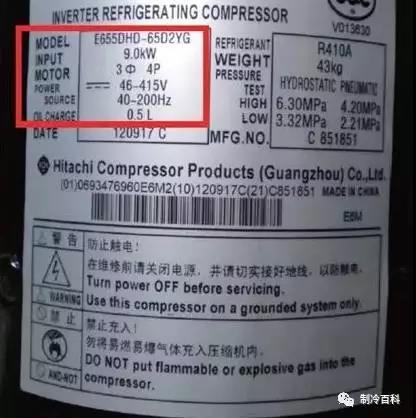
when handling a new compressor, it is necessary to note that the compressor can not be flat or upside down, the angle of tilt should be kept within 30, also pay attention not to let the compressor from the oil balance point of the oil flow.

make sure the sealing rubber blocks of the compressor, oil, steam, oil distributor and drying filter are in good condition.

step 8: replace the gas-liquid separator, place the steam separator in a suitable position with the chassis, connect the steam inlet and outlet pipe, and then connect the nitrogen joint on the steam connection pipe. The position of the nitrogen joint can be selected according to the site conditions, can Use by-pass interface or directly connected in the steam into the pipeline, the pipeline can be used with a larger connection with tape, need to ensure that nitrogen can flow through the steam smoothly.
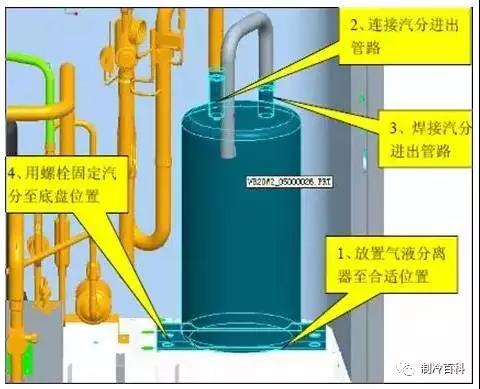
step 9: replace the liquid tank. If the tank is removed after inspection, no foreign matter and impurities can be removed. Because the tank structure is only equivalent to a container tank, does not involve complex structure, and generally does not need to be replaced, however, if there are impurities and foreign matter, it must be replaced, because the tank can not clean up the internal contamination.
Step 10: change the compressor
1, if only the replacement of constant frequency compressor
2, need to change the frequency of compressor
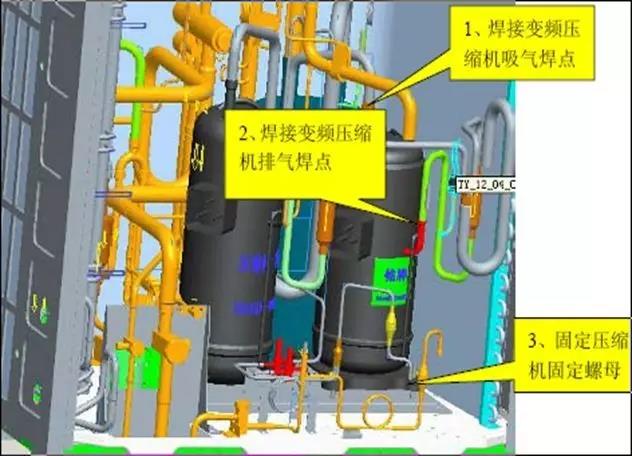
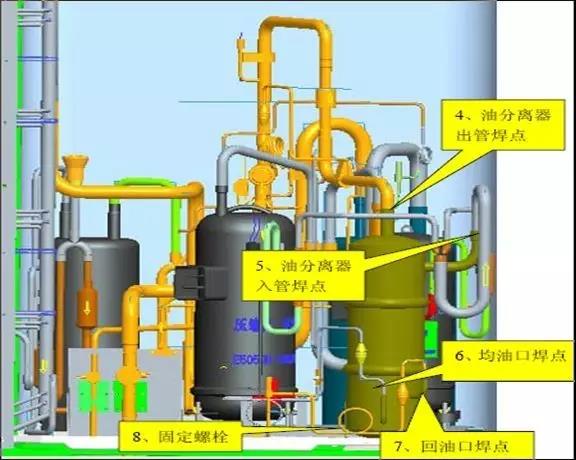
replacement of the compressor need to pay attention to the specific matters:
1, if the compressor suction and exhaust port is copper-plated steel pipe, a solder containing at least 5% silver is required. Welding gap should be 0.1 ~ 0.3 mm, to prevent welding blockage or false welding. Do not overheat the nozzle during welding.
2.After welding the pipeline system, it is necessary to fix the compressor with pads and bolts to ensure the stability of the compressor.
3, the compressor wiring phase sequence error or frequency conversion and fixed frequency mixing of the situation.
Step 11: change the oil separator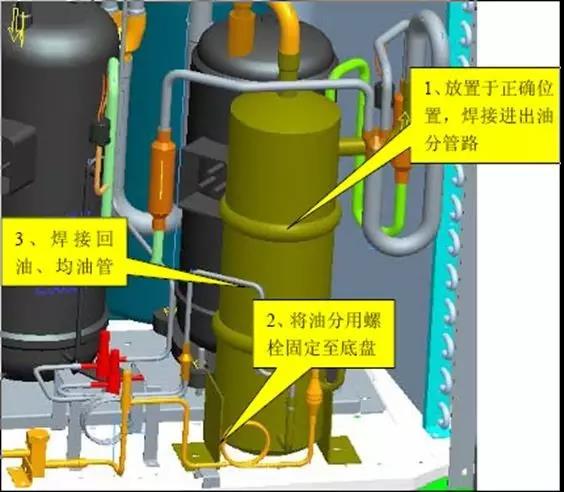
step 12: System leak detection
1, first for each solder joint inspection, first observe whether the solder joint is smooth and there is no obvious welding hole and other abnormal conditions;
2, for the Unit System Nitrogen pressure, make the system pressure above 25kgf, close the unit size valve, ensure the pressure inside and outside the machine at the same time above 12h, if the pressure does not change, you can start to vacuum, otherwise to re-leak detection until leak detection.
Step 13: Add Refrigeration Oil
1, connect the unit size valve, vacuum more than 30 minutes. Connect the low pressure measuring valve with a rubber tube, open the container where the oil is stored, and pour the oil into the measuring cup to measure the appropriate additional amount. After adding proper lubricant, close the low pressure measuring valve to ensure the seal.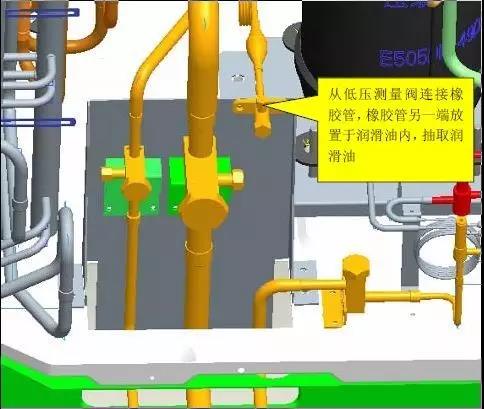
Note: The refrigerant oil of the compressor plays a very important role in the normal operation of the compressor. It must be filled with the correct grade and quality lubricating oil according to the requirements of the equipment.
Step 15: Filling Refrigerant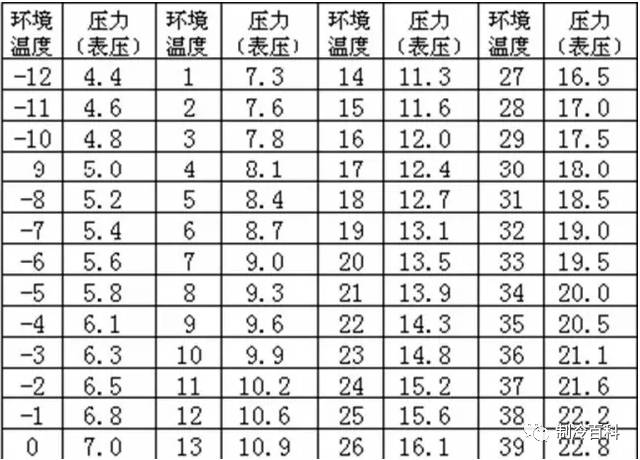
additional refrigerant charge calculated according to the Nameplate Rating Plus Piping; if the unit is a multi-module connection installation, only the refrigerant of the unit outside the unit is released before maintenance, after pouring 80% of the rated pouring amount of the nameplate of the external machine, the adjustment is made through the starting and debugging parameters.
Step 16: Connect the electrical components, install the electrical box, connect the compressor cable and the corresponding electrical heating tape according to the previous mark and the circuit diagram behind the electrical box cover. Note: must be carefully checked according to electrical wiring diagram, must ensure that the wiring is correct!
Step 17: start-up Commissioning, Unit start-up commissioning, respectively running refrigeration full-open, refrigeration single-open, heating full-open and heating single-open unit operating conditions, each operating condition requires operation of more than 30 minutes, and data analysis, adjustment of the unit system, make sure all the parameters are in order.
Article Collation from the "encyclopedia of refrigeration" cold and warm life, Binger accompanied -
2020-05-05
Flammable and explosive R290 refrigerant, COME IN TO UNDERSTAND!
Propane, a hydrocarbon refrigerant, Molecular Formula C3H8, appearance colorless gas, pure odorless, slightly soluble in water, soluble in ether, ethanol, flashpoint °c-104. The upper explosion limit is% v / V 9.5, the lower explosion limit is% v / V 2.1, the relative density of air is 11.56, the heat of combustion is KJ / Mol: 2217.8, the ignition temperature is 450 ~ 470 °C. Note: Flash Point: the temperature at which a mixture of steam and air on the surface of a flammable liquid first occurs in contact with fire. Health Hazards: SIMPLE ASPHYXIA and anesthesia. Short-term exposure to 1% propane does not cause symptoms; concentrations below 10% cause only mild dizziness; high concentrations of exposure can lead to anesthesia, loss of consciousness; extremely high concentrations can lead to suffocation. Hazard characteristics: Flammable Gas, mixed with air can form explosive mixture, heat source and open fire with the risk of combustion and explosion, Safety Class A 3. Small charge: R290 refrigerant dosage is only R22, R410A of 40% ~ 55% , less dosage, more economic. Energy Saving: Low freezing point, higher latent heat of evaporation, faster cooling rate per unit time; less isentropic compression than work, easier compressor work, longer compressor life; small molecular weight, good fluidity, lower conveying pressure, reduced the load of the compressor. Using R290 refrigerant, the energy saving rate can reach 15 ~ 30% .

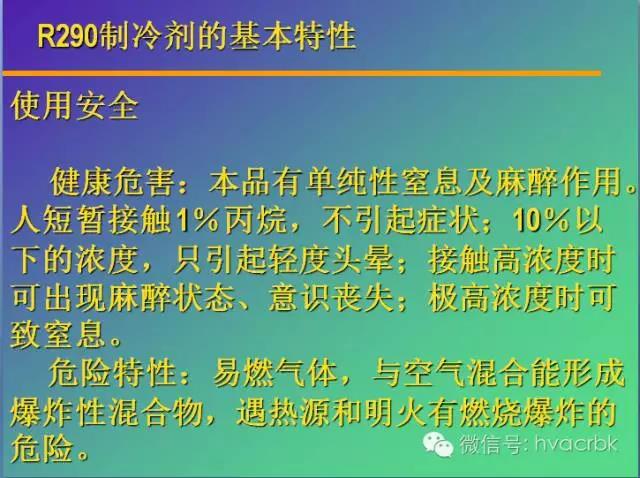
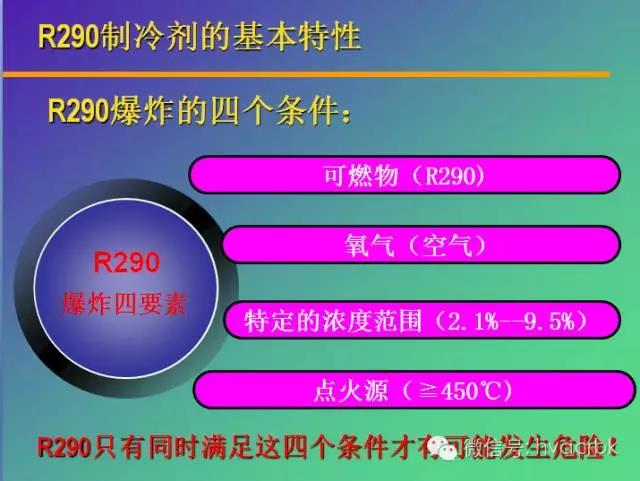
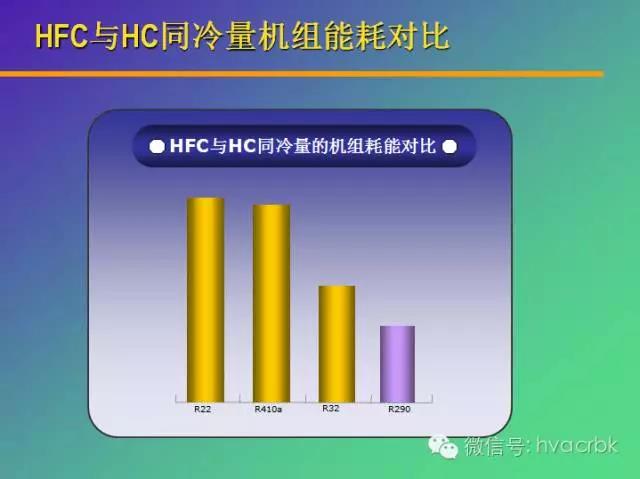
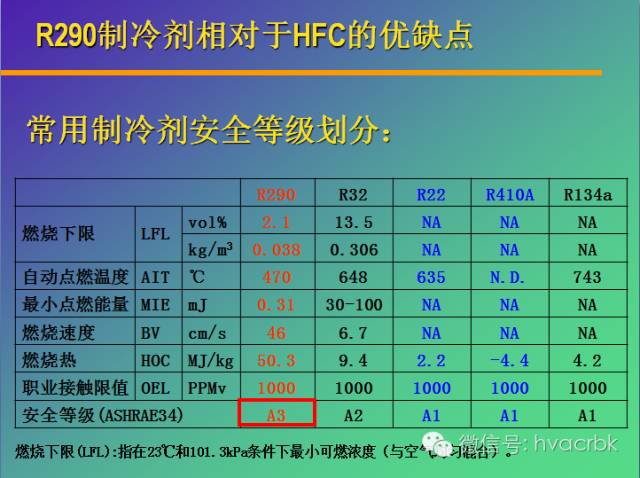



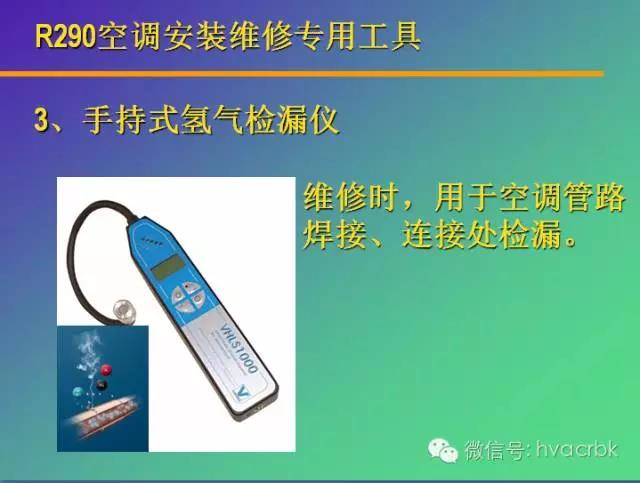
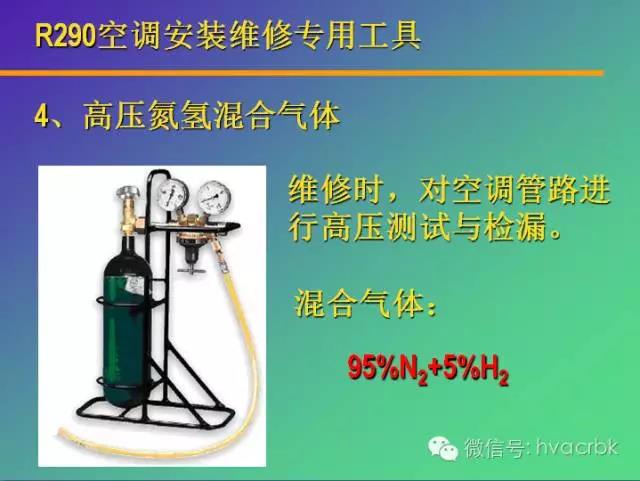
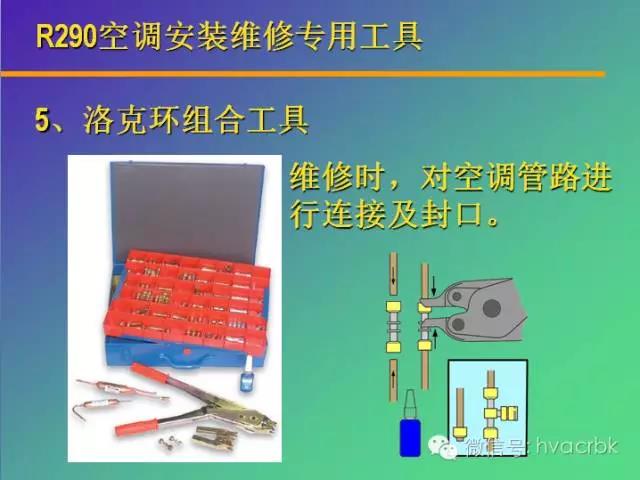
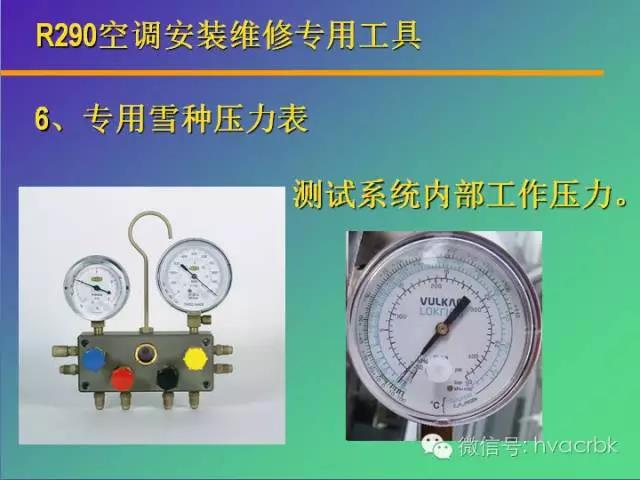
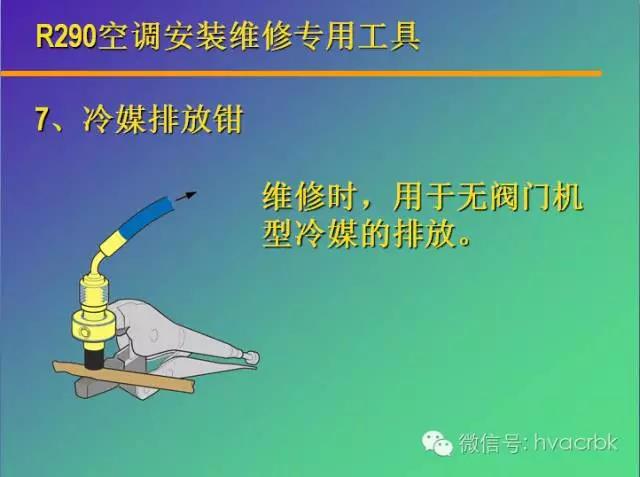
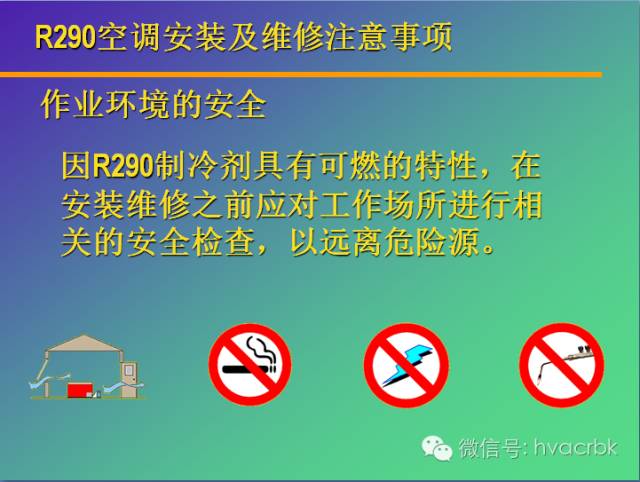
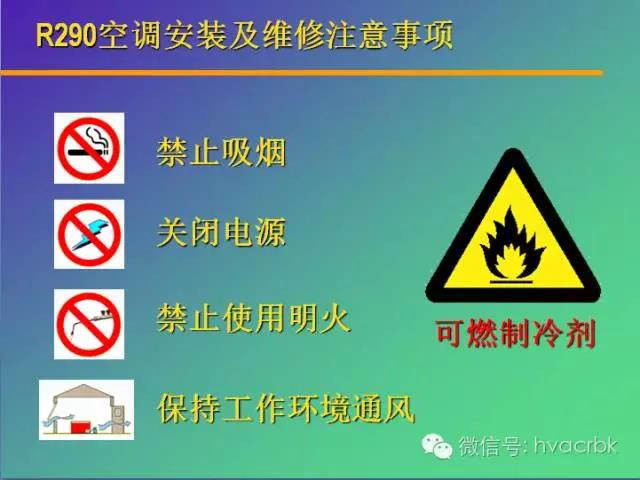
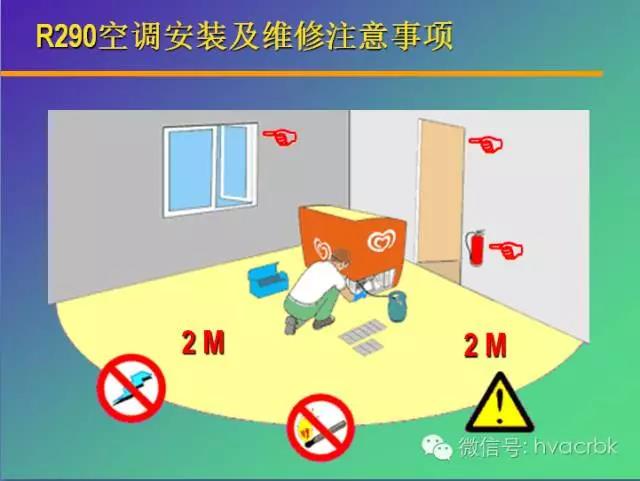
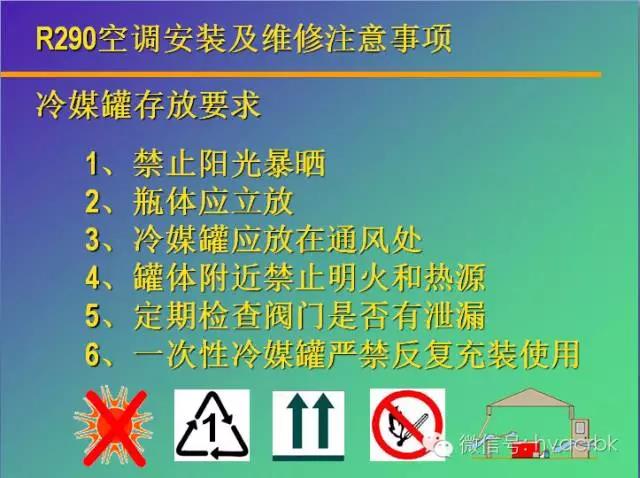
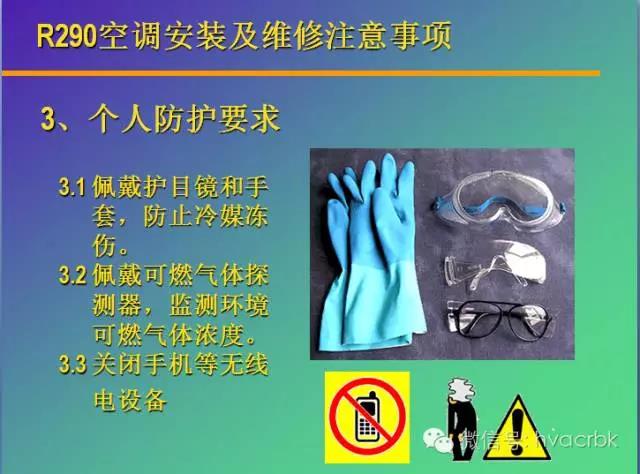
Article Collation from the "encyclopedia of refrigeration"
cold and warm life, Binger accompanied ! -
2020-11-03
How to choose air conditioning main engine? What does common air conditioning main engine have?
How to choose air conditioning main engine? What does common air conditioning main engine have?
一、WATER-COOLED CHILLERS:
The water cooled chiller is part of the chiller in the air conditioning, and its refrigerant is water, called the Chiller, and the condenser is cooled by heat exchange of normal temperature water. So called water-cooled units, and water-cooled units known as the opposite of air-cooled units, air-cooled units by the condenser and outdoor air forced ventilation heat exchange to achieve refrigeration since.
1、Screw chillers: Screw chillers are large and medium-sized chillers that provide chilled water. Commonly used in National Defense Research, energy development, transportation, hotels, restaurants, light industry, textile and other departments of air conditioning, as well as water conservancy and power engineering frozen. The screw type chiller is a complete refrigeration system which is composed of screw refrigeration compression group, condenser, evaporator, automatic control element and instrument. It has the advantages of compact structure, small volume, light weight, small area, convenient operation and maintenance, smooth operation and so on, so it has been widely used.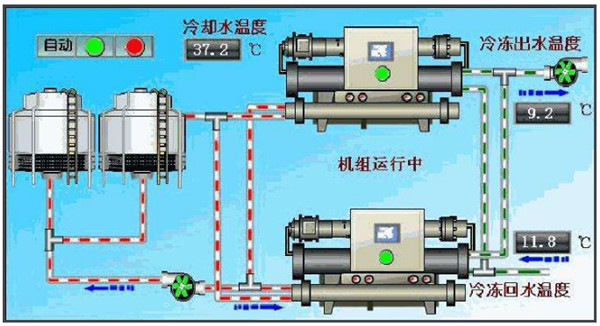
2、Centrifugal chillers: chillers are made up of Centrifugal chillers, complete with evaporators, condensers and throttling controls, and electrical meters. The capacity of a single chiller ranges from 700 to 420OKW. Applicable to sub-large and extra-large projects.
二、AIR-COOLED CHILLERS:
water-cooled chillers and air-cooled chillers, the main difference between them lies in the condenser. The condenser of a water-cooled chiller takes away heat mainly by circulating cooling water. Unlike water-cooled chillers, air-cooled chillers use fans for cooling. Finned condenser is usually used. The finned condenser is actually a piece of aluminum. The area where the heat transfer is about to take place is externally mounted with the finned condenser for efficient heat dissipation. The hot air is then discharged through a powerful fan.
The modular machine was developed on the basis of the VRV system, which was invented and patented in 1985 by the Czech Wind Group of Australia. It will change the traditional Freon pipeline into the water system, the combination of indoor and outdoor units into refrigeration units, indoor units into fan coil. The refrigeration process is realized by the heat transfer of the refrigerant water. The module machine is named because it can automatically adjust the number of starting machine according to the requirement of cooling load and realize flexible combination.
AIR-COOLED WATER SCREW MACHINE:
The difference between air-cooled screw and water-cooled screw is that a condenser adopts a fin-type condenser, another is a tube-shell type condenser, which is suitable for a large cold capacity factory, market.
三、VRV systemVRV system is the abbreviation of variable Refrigerant Volume system, I. E. Variable Refrigerant flow system. Its form is a group of outdoor machine, by the function machine and constant speed machine, frequency conversion machine composition. Through the parallel outdoor machine system, the refrigerating pipe is centralized into a pipe system, and the suitable capacity of the indoor machine is selected from 122.5 kw to 1.5 kw according to the matching of the capacity of the indoor machine, that is up to a group of outdoor units can be connected to 30 indoor units.
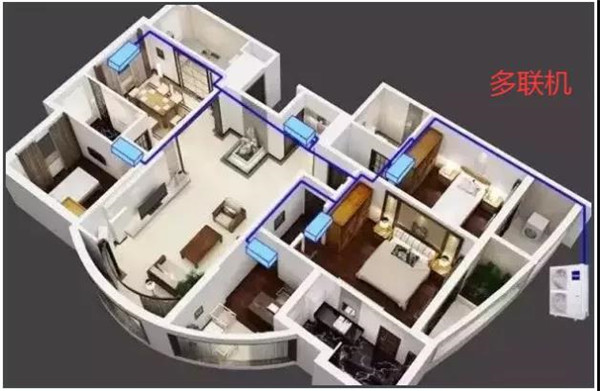
Indoor machine has ceiling embedded type, hanging wall type and so on. Different types of indoor single machine can be connected to a refrigeration loop, and can be controlled separately. The minimum capacity of indoor single machine is 0.6 kw and the maximum is 3.75 kw. The capacity of indoor machine can be adjusted from 50% to 130% of outdoor machine capacity.
四、How to choose a refrigeration unit
Calculate air conditioning cooling load according to the air conditioning area and room function of the building;
Statistical Building Air conditioning total load;
Most buildings need to consider the simultaneous use of rooms, the general simultaneous use of buildings for 70-80% , special circumstances need to be determined according to the building function and use;
The cooling load of the refrigerator is the product of the total air-conditioning load of the building and the simultaneous utilization ratio. According to the calculated cooling load of the refrigerator, both the refrigeration host can be selected;
The number of refrigeration units can be determined according to the building owner and the equipment room provided
The type of host machine can be determined according to the actual situation of the owner or according to the project situation, and the most suitable type of host machine can be chosen.
An office Gross leasable area for 2000 square meters, air-conditioning area for 1500 square meters, the whole building to use VRV system, should choose how much cooling capacity of the external unit?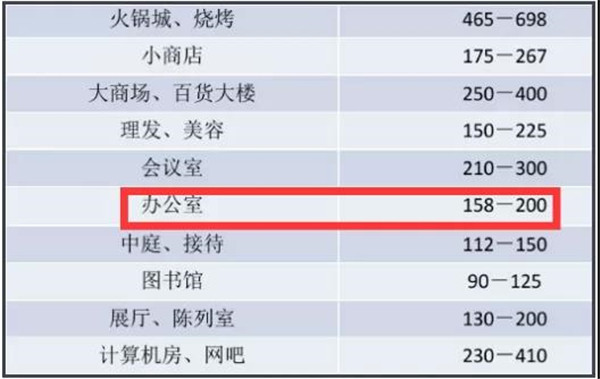
Calculations based on Empirical Cooling Capacity: 1500 m2200w/m2 = 300kw/2500w = 120hp.
-
2021-01-19
Common problems of after-sales maintenance of refrigeration units
Common problems of after-sales maintenance of refrigeration units
1. Liquid back
1. For refrigeration systems using expansion valves, liquid return is closely related to the improper selection and use of expansion valves. Excessive selection of the expansion valve, too small superheat setting, incorrect installation of the temperature sensing bulb, damaged adiabatic dressing, and failure of the expansion valve may cause liquid flood back.
2. For small refrigeration systems that use capillary tubes, excessive liquid addition will cause liquid backflow.
3. When the evaporator is severely frosted or the fan fails, the heat transfer becomes poor, and the unevaporated liquid will cause liquid back.
4. Frequent temperature fluctuations in the cold storage will also cause the expansion valve to malfunction and cause liquid backflow.
For refrigeration systems where liquid return is difficult to avoid, the installation of a gas-liquid separator and the use of pump-down shutdown (that is, let the compressor drain the liquid refrigerant in the evaporator before shutdown) control can effectively prevent or reduce the harm of liquid return.
2.Start with liquid
1. When the return air cooling compressor is started, the phenomenon that the lubricating oil in the crankcase foams violently is called start with liquid.
2. The foaming phenomenon when starting with liquid can be clearly observed on the oil sight glass.
3. The root cause of starting with liquid is that a large amount of refrigerant dissolved in the lubricating oil and sinking under the lubricating oil suddenly boils when the pressure drops suddenly and causes the lubricating oil to bubble. The duration of bubbling is related to the amount of refrigerant, usually several minutes or ten minutes. A lot of foam floated on the oil surface and even filled the crankcase. Once sucked into the cylinder through the intake duct, the foam will be reduced to liquid (a mixture of lubricating oil and refrigerant), which can easily cause liquid hammer. Obviously, the hydraulic shock caused by starting with liquid only occurs in the starting process.
4. Unlike liquid flood back, the refrigerant that caused the start with liquid enters the crankcase by means of "refrigerant migration". Refrigerant migration refers to the process or phenomenon in which the refrigerant in the evaporator enters the compressor in gas form through the return line and is absorbed by the lubricating oil when the compressor stops running, or is mixed with the lubricating oil after being condensed in the compressor.
5. After the compressor is stopped, the temperature will decrease and the pressure will increase. Because the partial pressure of refrigerant vapor in the lubricating oil is low, it will absorb refrigerant vapor on the oil surface, causing the phenomenon that the crankcase air pressure is lower than the evaporator air pressure. The lower the oil temperature and the lower the vapor pressure, the greater the absorption power of refrigerant vapor. The steam in the evaporator will slowly "migrate" to the crankcase. In addition, if the compressor is outdoors, when the weather is cold or at night, its temperature is often lower than that of the indoor evaporator, and the pressure in the crankcase is also lower. After the refrigerant migrates to the compressor, it is easy to be condensed and enter the lubricating oil.
6. Refrigerant migration is a very slow process. The longer the compressor is down, the more refrigerant will migrate into the lubricant. This process will proceed as long as there is liquid refrigerant in the evaporator. Because the lubricant with dissolved refrigerant is heavier, it will sink to the bottom of the crankcase, and the floating lubricant can absorb more refrigerant. To
7. Due to structural reasons, the pressure of the crankcase will decrease much more slowly when the air-cooled compressor is started, the foaming phenomenon is not very severe, and the foam is difficult to enter the cylinder, so the air-cooled compressor does not have the problem of liquid hammering when starting with liquid. To
8. In theory, the installation of a crankcase heater (electric heater) on the compressor can effectively prevent the migration of refrigerant. After a short period of shutdown (such as at night), keeping the crankcase heater energized can make the lubricating oil temperature slightly higher than other parts of the system, and refrigerant migration will not occur. After a long period of shutdown (such as a winter), heating the lubricating oil for several or ten hours before starting up can evaporate most of the refrigerant in the lubricating oil, which can greatly reduce the possibility of liquid shock during startup with liquid It can also reduce the harm caused by refrigerant erosion. However, in practical applications, it is difficult to maintain the heater's power supply after shutting down or to supply power to the heater ten hours before starting up. Therefore, the actual effect of the crankcase heater will be greatly reduced. To
9. For larger systems, let the compressor drain the liquid refrigerant in the evaporator before shutting down (called pump-down shutdown), which can fundamentally avoid refrigerant migration. The installation of a gas-liquid separator on the return gas pipeline can increase the resistance of refrigerant migration and reduce the amount of migration. To
3. oil return
1. When the compressor is higher than the evaporator, the oil return bend on the vertical return pipe is necessary. The return bend should be as compact as possible to reduce oil storage. The spacing between the oil return bends should be appropriate. When the number of return bends is large, some lubricant should be added. To
2. The oil return pipeline of the variable load system must also be careful. When the load is reduced, the air return speed will decrease, too low speed is not conducive to oil return. In order to ensure the oil return under low load, the vertical suction pipe can adopt double vertical pipes. To
3. Frequent starting of the compressor is not conducive to oil return. Since the compressor stops for a short continuous operation time, there is no time to form a stable high-speed air flow in the return pipe, and the lubricating oil can only stay in the pipe. If the oil return is less than Ben oil, the compressor will be short of oil. The shorter the operating time, the longer the pipeline and the more complex the system, the more prominent the oil return problem.
4. Lack of oil will cause serious lack of lubrication. The root cause of the lack of oil is not the amount and speed of the compressor, but the poor oil return of the system. The installation of an oil separator can quickly return oil and extend the compressor running time without oil return.
5. The design of evaporator and return gas pipeline must take oil return into consideration. Maintenance measures such as avoiding frequent starting, timing defrosting, timely replenishment of refrigerant, and timely replacement of worn piston components also help to return oil.
4. Evaporation temperature/return air temperature/return air pressure
1. When the evaporation temperature increases by 10℃, the motor load can increase by 30% or even higher, causing the phenomenon of small horse-drawn carts. Therefore, if the low-temperature compressor is used in the medium-to-high temperature system and the cold storage cooling process lasts too long, the compressor will be overloaded for a long time, which will cause great damage to the motor, causing the motor to encounter unexpected situations such as voltage fluctuations and surges in the future. It is easy to burn at times.
2. The lower the evaporating temperature, the smaller the refrigerant mass flow, and the smaller the motor power actually required. Therefore, when air conditioning compressors and medium-high temperature refrigeration compressors are used at low temperatures, although the actual power consumption of the motor is much smaller than the nominal power, it is still too large compared to the actual power demand and cooling at low temperatures, and the motor cooling is easy problem appear. To
3. The return air temperature is relative to the evaporation temperature. In order to prevent liquid return, the return gas pipeline generally requires a return gas superheat of 20°C. If the return air pipe is not well insulated, the superheat will far exceed 20°C. To
4. The higher the return air temperature, the higher the cylinder suction temperature and exhaust temperature. Every time the return air temperature increases by 1°C, the exhaust temperature will increase by 1 to 1.3°C.
5. For the return air cooling compressor, the refrigerant vapor is heated by the motor when it flows through the motor cavity, and the cylinder suction temperature is once again increased. The amount of heat generated by the motor is affected by power and efficiency, while the power consumption is closely related to displacement, volumetric efficiency, working conditions, friction resistance, etc.
6. Although reducing the evaporation temperature can increase the freezing temperature difference, the refrigeration capacity of the compressor is reduced, so the freezing speed is not necessarily fast. What's more, the lower the evaporation temperature, the lower the refrigeration coefficient, but the load increases, the operating time is prolonged, and the power consumption will increase. To
7. Reducing the resistance of the return air pipeline can also increase the return air pressure. The specific methods include timely replacement of the dirty return air filter, and minimize the length of the evaporation tube and the return air pipeline. To
8. In addition, insufficient refrigerant is also a factor of low return pressure.
5. the temperature is too high
1. The refrigerant charge in the system is insufficient, even if the expansion valve is opened to the maximum, the liquid supply will not change, so that the refrigerant vapor in the evaporator will overheat and the suction temperature will increase.
2. The opening of the expansion valve is too small, resulting in insufficient refrigerant circulation in the system, less refrigerant entering the evaporator, high overheating, and high suction temperature. To
3. The expansion valve port filter is blocked, the liquid supply in the evaporator is insufficient, the amount of refrigerant liquid is reduced, and a part of the evaporator is occupied by superheated steam, so the suction temperature rises. To
4. The suction temperature is too high due to other reasons, such as poor heat insulation of the return air pipe or too long pipe, which can cause the suction temperature to be too high. Under normal circumstances, the compressor cylinder head should be half cold and half hot.
6. he temperature is too low
1. Too much refrigerant charge, occupying part of the condenser volume and increasing the condensing pressure, and the liquid entering the evaporator increases accordingly. The liquid in the evaporator cannot be completely vaporized, so that the gas sucked by the compressor contains liquid droplets. In this way, the temperature of the return air duct drops, but the evaporation temperature does not change because the pressure does not drop, and the degree of superheat decreases. Even if the expansion valve is closed, there is no significant improvement. To
2. The opening of the expansion valve is too large. The temperature sensing element is too loosely bound, the contact area with the air return pipe is small, or the temperature sensing element is not wrapped with insulation material and its wrapping position is wrong, etc., resulting in inaccurate temperature measurement of the temperature sensing element, close to the ambient temperature, causing the expansion valve to operate The opening degree increases, resulting in excessive liquid supply. To
7. The influence of evaporating temperature on refrigeration efficiency
1. The heating temperature has a great influence on the refrigeration efficiency. When it decreases by 1 degree, the same cooling capacity needs to increase the power by 4%. Therefore, if conditions permit, appropriately increasing the evaporating temperature is beneficial to improving the cooling efficiency of the air conditioner. of. The evaporating temperature of household air conditioners is generally 5 to 10 degrees lower than the air outlet temperature of the air conditioner. During normal operation, the evaporating temperature is 5 to 12 degrees, and the outlet temperature is 10 to 20 degrees.
8. exhaust temperature / exhaust pressure / exhaust volume
1. The main reasons for the high exhaust temperature are as follows: high return air temperature, large heating capacity of the motor, high compression ratio, high condensation pressure, adiabatic index of the refrigerant, and improper refrigerant selection.
2. For R22 compressor, when the evaporating temperature decreases from -5°C to -40°C, the COP will generally decrease by 4 times, and other parameters will not change much, and the temperature rise of the gas in the motor cavity will increase by three or four times. As the cylinder suction temperature increases by 1°C, the exhaust temperature can increase by 1 to 1.3°C. Therefore, when the evaporation temperature is reduced from -5°C to -40°C, the exhaust steam temperature will rise by about 30-40°C. In the return air cooling type semi-hermetic compressor, the temperature rise of the refrigerant in the motor cavity is roughly between 15 and 45°C.
3. In the air-cooled (air-cooled) compressor, the refrigeration system does not pass through the windings, so there is no motor heating problem.
4. The exhaust temperature is greatly affected by the compression ratio (condensing pressure/evaporating pressure, generally 4). Under normal circumstances, the discharge pressure of the compressor is very close to the condensing pressure. When the condensing pressure increases, the compressor discharge temperature also increases. The larger the compression ratio, the higher the exhaust temperature and the reduction of the air delivery coefficient, which reduces the cooling capacity of the compressor and increases the power consumption.
5. Reducing the compression ratio can significantly reduce the exhaust temperature. Specific methods include increasing the suction pressure and reducing the exhaust pressure. The suction pressure is determined by the evaporation pressure and the resistance of the suction line. Increasing the evaporation temperature can effectively increase the suction pressure and rapidly reduce the compression ratio, thereby reducing the exhaust temperature. To
6. Practice shows that reducing the exhaust temperature by increasing the suction pressure is simpler and more effective than other methods.
7. The main reason for excessive exhaust pressure is that the condensing pressure is too high (there is air in the system; the refrigerant charge is too much, and the liquid occupies the effective condensing area; the condenser has insufficient heat dissipation area, fouling, cooling air volume or insufficient water volume , Cooling water or air temperature is too high, etc.). It is very important to choose a suitable condensing area and maintain sufficient cooling medium flow.
8. Exhaust pressure is too low. Although the phenomenon is manifested in the high-pressure side, the reason is mostly at the low-pressure side.
9. Insufficient air displacement is mainly due to the fact that the compressor suction pipe is too long and the pipe diameter is too small compared with the compressor’s design air volume, which increases the suction resistance, affects the suction volume and reduces the discharge volume. .
9. liquid strike
1. In order to ensure the safe operation of the compressor and prevent liquid hammer, it is required that the suction temperature be higher than the evaporation temperature, that is, it should have a certain degree of superheat. The degree of superheat can be achieved by adjusting the opening degree of the expansion valve. To
2. Avoid excessively high or low temperature. If the suction temperature is too high, that is, the overheating is too high, which will cause the compressor discharge temperature to rise. If the suction temperature is too low, it means that the refrigerant is not completely evaporated in the evaporator, which not only reduces the heat exchange efficiency of the evaporator, but the suction of wet steam will also cause compressor liquid hammer. The suction temperature should be 5-10℃ higher than the evaporation temperature under normal circumstances. To
10. overheating
1. For the commonly used R22 refrigerant, the cooling capacity of the compressor decreases with the increase of the effective superheat. When the superheat is 10℃, the cooling capacity is 99.5% of the cooling capacity under saturated evaporation, and when the superheat is 20 At ℃, the cooling capacity is 99.3% of the cooling capacity under saturated evaporation. It can be seen that the attenuation of the cooling capacity with the increase of superheat is very small.
2. The refrigerant maintains a certain degree of superheat, which can further prevent the liquid hammer phenomenon in the cylinder. For low-temperature refrigeration systems, appropriately increasing the effective superheat can make the lubricating oil return to the compressor smoothly. But as the compressor suction superheat increases, its discharge temperature also rises. Excessive discharge temperature will make the lubricating oil viscosity thinner and even carbonize, affecting the normal operation of the compressor, so the suction superheat should be controlled Within a certain range.
11. Add fluoride
1. When the amount of fluorine is small or its regulating pressure is low (or partially blocked), the valve cover (bellows) of the expansion valve and even the liquid inlet will be frosted; when the amount of fluorine is too small or there is basically no fluorine, the appearance of the expansion valve No response, only a faint sound of airflow can be heard.
2. See from which end the icing starts, whether it is from the dispensing head or the return pipe from the compressor. If the dispensing head is short of fluorine, the compressor is more fluorine. -
2021-02-23
Common sense of using air conditioning in extreme rain and snow!
Common sense of using air conditioning in extreme rain and snow!
At present, most mainstream brand air conditioners on the market have a minimum working temperature of -3°C to 7°C, and even some brands of heating outdoor units will freeze at 0°C! The editor below is going to zoom in! Offer the most professional extreme rain and snow weather air conditioner to use common sense to watch.
Common sense 1
Weather with low temperature and high humidity will increase the heat exchange and frosting of the outdoor unit of the air conditioner, and the heat exchange effect will be worse. Therefore, the heating effect of the air conditioner will decrease.Common sense 2
In order to ensure the normal operation of the air conditioner, the air conditioner itself has an automatic frosting function. The defrosting function, simply put, is a short "cooling operation" (the indoor unit does not blow out), allowing the outdoor unit to become a condenser for a few minutes, allowing the high-temperature refrigerant to defrost its own frost, and then automatically resume the system Hot running.Common sense 3
The defrosting process is automatic and cannot be controlled manually. In addition to causing the heating effect to decrease, it will also cause the indoor unit to have no hot air, the outdoor unit to emit white smoke (water vapor), the outdoor unit to flow black water, the venting sound (caused by the four-way valve switching), etc., these are all normal phenomenon.Common sense 4
Do not cut off the power supply of all air conditioners, and require continuous power supply to ensure that the outdoor unit crankshaft heater can continue to heat the compressor and ensure that the refrigerating oil does not freeze for good lubrication.Common sense 5
For air conditioners with a water system (multi-function VRV, etc.), please ensure that the power is supplied or take other measures according to the instruction manual. Otherwise, the protection function will not operate, and the low temperature below the freezing point may cause the water system to freeze. When the water freezes It will expand in volume and freeze the board, water pipe or fan coil.Common sense 6
The outdoor unit should be well ventilated to prevent the snow from burying the outdoor unit, and prevent the falling of snow from damaging the fan blades of the outdoor unit. Sometimes the snow can freeze the fan blades of the outdoor unit and cause the air conditioner to not work properly.Common sense 7
Air conditioners are high-current electrical equipment and should be powered separately, and all power cords should not have connectors. If there are connectors or sparks on the socket plugs, be sure to check and dispose of them. -
2021-04-22
Summary and analysis of 11 cases of air-conditioning water leakage
Summary and analysis of 11 cases of air-conditioning water leakage
Cause Analysis: The newly installed air-conditioning room machine is leaking. After the machine is turned on and checked, it is found that after running for half an hour, the surface of the external drainage pipe about 2 meters long in the interior part is covered with water droplets. The office building is close to the river, and the environment humidity is very high, the Room is obviously larger and less enclosed, which leads to a lot of condensed water discharged from the inner side of the air conditioner. The Air condenses on the outer wall of the external drainage pipe because the external drainage pipe is only wrapped with a thin layer of tape.
Solution: Add a thermal insulation sponge on the outer wall of the external drainage pipe and re-wrap it. In the south humidity big area, the heat insulation thermal insulation sponge wrap must be in place. Case 8, drainage pipe broken leakage failure
phenomenon: internal machine leakage, start a period of time indoor machine has a large amount of water discharge, but outdoor drainage pipe did not condensate water discharge.
Cause Analysis: The main cause of water leakage is that the drain pipe and accessories connected with the water plate are damaged during installation or are bitten by mice during use.
Solution: replace the damaged drainage pipe, check whether there is a mechanism causing the damaged drainage pipe again and take appropriate protective measures.
Case 9, the system caused by fluoride leakage failure
phenomenon: air-conditioning operation for a period of time after the air-conditioning leakage, evaporator fin frosting or icing phenomenon.
Cause Analysis: The user reported that the internal engine was leaking, and after 10 minutes of on-site operation, found that the internal engine wind wheel began to blow water, the refrigeration mode continued to operate for more than 20 minutes, and found that there was a slight frost and ice on the fins near the input pipe of the evaporator, measuring System pressure with pressure gauge, the system pressure is very low 3KG, you can judge the system serious lack of fluoride.
Solution: Check the leak point, found that the connection pipe and low-pressure valve body connection misalignment lead to nut lock position leakage fluorine phenomenon, re-connect and lock, re-evacuation, add refrigerant after normal test machine.
Case 10, evaporator half leakage failure
phenomenon: Air Conditioning operation for a period of time after the air conditioning leakage.
Cause Analysis: After running for a period of time, the air conditioner leaked water. After 20 minutes of running, it was found that the air conditioner began to blow water. After opening the panel frame, it was found that the evaporator had several long U Tube Fins, which were very cold and had a lot of condensed water, the other evaporator fins were not obviously cool; the system was suspected to be deficient in fluorine, the system pressure was measured with a pressure gauge and the system pressure was normal; after a period of time, it was found that the long u-tube fins began to hang a lot of water and put their hands on the air outlet, it is found that the temperature difference between the fins of the two-stream U Tube is large, which can be used to judge the half-block of the evaporator and cause the deviation of the refrigerant When the evaporator is half blocked, the temperature of the Long U Tube Fin with large flow of snow species is lower, and the temperature of the Long U Tube Fin with small flow of snow species is higher, resulting in a large temperature difference between the two flow paths, the Long U Tube Fin with large flow of snow seeds condenses a large amount of condensed water and blows out with the wind.
Solution: Consult with the user after the replacement of the evaporator troubleshooting, for welding or semi-blocking system caused by partial flow heat exchanger condensation caused by the performance of a good distinction: the entire duct is full of fine water droplets, at the same time, water droplets can also be seen on the turbine blades.
Case 11, embedded air-conditioning leakage fault
phenomenon: internal leakage, running lights flashing.
CAUSE ANALYSIS: After inspection, the water directly overflows from the water disc, check the drainage pipe drainage, found that the water is very small preliminary judgment for drainage pump drainage is not enough, replacement of drainage pump test machine is normal. Solution: replace the drainage pump. The drainage method of the embedded machine is different from that of the split machine, which is natural drainage, while the embedded machine relies on the drainage pump. -
2021-05-28
What's the difference between AC inverter and DC inverter air conditioner?
What's the difference between AC inverter and DC inverter air conditioner?
Household air conditioning is divided into fixed frequency and frequency conversion, the difference between the two lies in the control mode of compressor speed. Constant speed air conditioning compressor speed is fixed, not variable, this kind of air conditioning refrigeration (heat) output of cold (heat) is also fixed, not adjustable, so the temperature adjustment can only be adjusted by the compressor on or off.
The compressor speed of frequency conversion air conditioner is not fixed and can be changed. The output cold (heat) quantity of refrigeration (heat) can also be adjusted. Therefore, the output cold quantity of air conditioner can be changed by changing the compressor speed. Frequency conversion air conditioning is divided into DC frequency conversion and AC frequency conversion, and their concepts and control methods are different. Next, we will analyze their advantages and disadvantages and differences one by one.
1、 Advantages and disadvantages of variable frequency air conditioner
1. Advantages of variable requency air conditioning
① Energy saving and power saving: due to the function of internal frequency converter, the compressor will not start frequently, and the starting current is also very small;
② Intelligent adjustment of room temperature: the compressor changes the speed intelligently according to the temperature change, so as to keep the room temperature at a constant value and make the human body feel more comfortable;
③ Low noise: compared with the constant frequency air conditioner, the noise is lower, which is caused by the unbalance of the compressor, and the frequent start-up noise of the compressor is higher than that of the constant frequency air conditioner;
④ Wide voltage operation: because the constant frequency air conditioner needs starting capacitor to start, the voltage should not be too low, but the variable frequency can realize soft start, which is not very strict on voltage input, especially suitable for rural areas with unstable voltage.
⑤ Fast cooling (heating): due to the special electronic expansion and throttling technology used in the frequency conversion air conditioner, and the high power operation when the temperature difference is large, the temperature rises or falls rapidly.
2. Disadvantages of variable frequency air conditioning
① Maintenance is difficult and expensive: because frequency conversion air conditioner has more frequency converters than ordinary air conditioner, and the circuit and structure are more complex, frequency conversion air conditioner is easy to break down. Although the production process has been improved, compared with constant frequency air conditioner, its failure probability is much higher, the price is higher, the maintenance is more expensive, and the maintenance cost is much higher. This is also where many refrigeration technicians make complaints about tucks.
② High price: due to the complexity and advantages of frequency conversion air conditioning, the price is about 1000 yuan more than ordinary air conditioning;
③ Other disadvantages: for example, it needs to be running all the time to reflect its energy saving and power saving characteristics.
2、 Difference between AC frequency conversion and DC frequency conversion
1. DC frequency conversion air conditioner
Working principle of DC frequency conversion air conditioner: convert 50 Hz AC power into DC power and send it to the main circuit of power module. The power module is also controlled by microcomputer. The difference is that the output of the module is DC power with variable voltage, and the compressor uses DC motor. Therefore, DC frequency conversion air conditioner can also be called full DC variable speed air conditioner.
The rotor of DC variable frequency compressor is made of rare earth permanent magnet material. Its working principle is: the rotating magnetic field produced by stator acts directly with the permanent magnetic field of rotor to realize the operation of compressor. The speed of the motor can be changed by changing the DC voltage sent to the motor. DC inverter air conditioner has no inverter link, which is more power-saving than AC inverter.
The efficiency of DC variable frequency compressor is 10% - 30% higher than that of AC variable frequency compressor, and the noise is 5 DB-10 dB lower. However, the cost of DC inverter air conditioning is higher than that of AC inverter air conditioning.
2. AC variable frequency air conditioner
The working principle of AC frequency conversion air conditioner: AC frequency conversion technology is a technology that changes the power frequency through the frequency converter, so as to change the speed of the compressor. The conversion from AC to DC is carried out through the frequency converter, and then the conversion from DC to AC is carried out through the frequency converter, so as to control the speed of the AC motor. The control of the inverter is to transmit the indoor temperature information to the microcomputer through the sensor, and output a certain frequency waveform to control the frequency of the inverter.
AC motor can be operated in high temperature, flammable environment, and do not need to clean the dirt of carbon brush regularly, but it is difficult to control the speed. AC motor is a rotating magnetic field movement, and the conductor does not move. Although the manufacture is relatively cheap, the starting performance and speed regulation performance of AC motor are poor.
The advantage of DC motor is that it is simpler in speed control, less power and quieter. The structure of DC motor is complex, the manufacture is difficult and the price is high. DC motor is the magnetic field does not move, the conductor moves in the magnetic field. Compared with AC, DC motor is more energy-saving and environment-friendly.

Full DC variable frequency air conditioning refers to the three core motors of air conditioning: variable frequency compressor motor, indoor fan motor and outdoor fan motor. They all use powerful DC motor. With the inherent advantages of DC motor and the organic combination of microcomputer technology, the air conditioning performance is further improved, the room temperature fluctuation is small, and the comfort is better, It is insensitive to the fluctuation of power supply voltage, and the cooling capacity varies from 35% to 117%.
3、 How to choose frequency conversion and fixed frequency?
The choice of frequency conversion or fixed frequency should be decided by itself. Frequency conversion can save electricity a lot of times, but for continuous work, if a period of time is less than 5 hours, and the month is not long, then its energy saving can not be reflected too much, it is not as good as constant frequency. If you pursue comfort, frequency conversion is the best choice.
If you don't use the air conditioner very frequently, you don't have to ask for comfort. At this time, you can consider fixed frequency, because the price is relatively cheap and the maintenance is easy. As for whether to choose a domestic brand or a Japanese brand, Xiaobian is still saying that, according to his own actual situation, it's good to have money to buy high-end brands and no money to buy domestic brands. After all, the price is much cheaper.
-
2021-07-16
The reason of compressor overflowing
The reason of compressor overflowing
In short, there are three reasons for the overflow of the compressor:
1.The condensation pressure of the refrigeration system is too high;
2.Too much refrigerant in the refrigeration system;
3.The compressor is missing the frozen oil.
Details are given below:
1、Poor heat dissipation of the external machine
Short circuit to external machine return and exhaust air:Such as the external machine is installed in the enclosed balcony, the narrow corridor, the house and other unventilated places, there are obstacles in front of the tuyere.
The external machine air volume is small and the cooling speed is slow: if the external machine condenser is too dirty or blocked by dust and oil, the fan motor speed is slow, the fan capacitance becomes smaller, and the temperature around the external machine is high.
2、External power supply voltage factor
The supply voltage is low or high, both cases will cause compressor high working current, and the domestic voltage is the majority, especially when the peak electricity.
If the power supply voltage (i. e. voltage before startup) is too low: let the user to rewiring, if the voltage is about 190V, consider the voltage stabilizer, if it is too low is invalid.
Check the pressure drop after startup: under normal circumstances, the pressure drop is only a dozen volts, and the pressure drop is too large, the power line or rewiring, and faults such as poor line contact should be eliminated.
3、Refrigeration system failure
When mixed with air in the refrigeration system: if there is air in the system, the air is often stored in the upper part of the condenser, because it cannot be determined through the condenser and whether there is air in the system. If there is air in the system, fluorine treatment should be evacuated.
Excessive fluoride: the compressor is in an overload state for a long time, which will eventually lead to the compressor overload jump machine. This condition shall release a partial fluorine to.
4、Housing / high internal temperature
Poor lubrication of the compressor: the height difference of indoor and external machines is more than 5 meters did not return the oil bend, or made the return oil bend on only one pipe, and the system can not return the oil smoothly. The temperature of the compressor slowly rises during the operation due to lack of lubrication, which finally leads to overheating jump.
Impurities in the system, too much water: make the lubricating oil deteriorate, carbonization, can not play a normal effect, resulting in the compressor temperature rise sharply and overheating jump machine. This generally occurs on the repaired machine or used machine for a long time. If the substances in the inspection system is black, apply nitrogen cleaning system, replace the compressor, capillary assembly, and take time to add fluorine.
5、The compressor cooling effect is poor
The system is too little fluorine, the compressor working temperature is very high, the high temperature coil is by inhaled refrigerant to cool, if the fluorine is too little, the system flow is small, can not meet 100% of the evaporator load, resulting in the suction heat increase, plus the compressor intake flow is small, cooling efficiency is greatly reduced, so that a long operation can lead to compressor thermal protection.
Common causes of compressor coil burning
1, air conditioning compressor starts frequently
During the starting process of air conditioning compressor, there is generally a voltage start-up circuit, but the starting current will exceed several times the rated current, and the starting temperature of air conditioning compressor motor rises very fast. If the air conditioning temperature is not set properly, the cooling temperature is too low, and the heating temperature is too high, the air conditioning compressor will switch on and off frequently, which will shorten the life of the air conditioning compressor.
2, air conditioning compressor starts frequently
Bad supply voltage quality such as too high or too low, have a bad impact on the air conditioning compressor motor, especially beyond the rated voltage range of the air conditioning compressor, the most improper, long-term operation makes the air conditioning compressor motor in an inefficient overheating state, resulting in poor insulation, motor windings burned. In addition, the three-phase voltage or current imbalance will also cause increased motor loss (iron and copper loss), the air conditioning compressor motor coil temperature is too high, the superheater protection is improper, the insulation of the air conditioning compressor motor burned, resulting in short circuit burning of the air conditioning motor coil.
3, compressor burned down
For air conditioning refrigeration system once compressor burning fault, must clean up the refrigeration system thoroughly, air conditioning compressor motor burning will have strong acid generation and stay in the system, if not clean, when the new air conditioning compressor motor operation, residual acid substances will corrode the air conditioning compressor motor insulation, causing the new air conditioning compressor burning.
4, copper system is not clean
It contains water, water will also cause poor insulation of the air conditioning compression motor; water and refrigerant and frozen oil circulation in the system, after high temperature and low temperature and other state changes, will produce acid substances, and then destroy the insulation layer of the motor, a long working time, the air conditioning compressor motor will be burned.
5, compressor is poorly cooled
The return temperature is too high or low to cool the compressor motor coil. The air-cooled heat pump unit occurs more frequently, and the high return temperature will also lead to too high exhaust temperature, resulting in a series of air conditioning compressor problems.
6, compressor start contactor fault
Contactor contact resistance is too large or sintering, causing short circuit burning of the air-conditioning compressor motor, or poor line contact, and the large starting current can easily burn the air-conditioning compressor.
7, metal chips
The mixed metal chips in the winding are responsible for short circuit and low ground insulation. Normal vibration of the compressor during the operation of each startup and the winding twisted by electromagnetic force cause the relative movement and friction between the metal debris between the winding and the winding paint line. Sharp metal chips can scratch the paint wrap wire insulation, causing a short circuit.
-
2021-08-30
What is the difference between the R22 and R404A cold storage systems?
What is the difference between the R22 and R404A cold storage systems?
In the past, many R22 refrigerators used R22 refrigeration, but now more and more R404A refrigerant is used, so why do cold storage use relatively high R404A refrigerant?What is the difference between the R22 and R404A cold storage systems?
First of all, R22 refrigerant is a non-environmentally friendly refrigerant, and developed countries in Europe and America have been eliminated from use.Although R404A GWP refrigerant is high, not a really environmentally friendly refrigerant, but relatively R22 is more environmentally friendly.In addition, the latent heat of R404A refrigerant is larger than R22, the thermal efficiency and refrigeration efficiency are higher, the system circulation volume is small, the filling amount is less than R22, the refrigeration speed is faster than R22, and the corresponding temperature under the same pressure is lower than R22. Therefore, many refrigeration equipment is used in cold storage with R404A refrigerant.
R22 and R404A cold storage system differences
1, R404A cold storage system and lubricating oil itself are very soluble with water, so the requirements for water and residues and cleanliness of the system are improved compared with the R22 cold storage system. Water control and impurity control of R404A system are a relatively important index, and the corresponding filter device in the system should be changed.
2, R404A cold storage system is about 1.2 times that of R22, the mass flow rate is about 1.5 times that of R22, and the exhaust flow rate increases and the resistance increases.In general, the condenser has a heat exchange capacity of 20% ~ 30% greater than the R22.
3,The saturation temperature of R404A cold storage system at the same temperature is different from R22, so the action mechanism of R404A thermal expansion valve is different from that of R22.At the same time, due to the R404A refrigerant and the solvent of lubricant to the different sealing materials, the sealing materials of the expansion valve should also be changed accordingly. Therefore, the R404A special expansion valve should be selected in the selection of thermal expansion valve.
4, Due to the high saturation pressure of R404A cold storage system than R22, the higher pressure vessel pressure resistance in the system, such as reservoir and gas-liquid separator.The safety valve and fuse setting value installed on the system accessories should also be changed accordingly.Since the gas density of R404A is about 50% greater than R22 under the same exhaust amount, the pipe diameter is larger than R22 using the R404A cold storage system.
5, The same compressor, the current of the R404A cold storage system should be greater than R22,, so the line diameter of the AC contactors, heat relays and cables of the compressor shall be adjusted.For system protection, the high pressure pressure switch set is adjusted from 2.45MPa to 2.7MPa.
6, Because the saturation pressure of the 404A cold storage system is different from R22, the air tightness test pressure is greater than R22. The vacuum is higher than R22, water content is lower than R22. The refrigerant shall be filled in liquid form to prevent the R404A configuration changes.
7, R404A is non-coboiling mixed work quality, the composition concentration of non-coboiling mixture varies with temperature and pressure, which brings certain difficulties to the production, debugging and maintenance of the refrigeration system, will also have a certain impact on the system heat conduction performance, especially when the refrigerant leakage, the system refrigerant needs to be completely replaced, so as to ensure the proportion of the mixed components, and to achieve the design refrigeration effect, otherwise it will get worse and worse.
The 8, R404A cold storage system, different from R22 lubricating oil, must be replaced by R22 with PVE ester oil.Eester lubricating oil and water have high affinity and poor dehydration, so contact with external air should be avoided as far as possible in use. The container shall be used as soon as possible, sealed, stay away from oxidant, strong alkali and strong acid and kept in well ventilated place; avoid contact with skin and eyes and vapor and spray. -
2021-10-27
Causes of compressor overcurrent
Causes of compressor overcurrent
In short, there are three reasons for the over-current of the compressor:
1. The condensation pressure of the refrigeration system is too high;
2. Too much refrigerant in the refrigeration system;
3. The compressor is short of refrigerant oil
Let's explain in detail below:
Poor external heat dissipation
Short circuit of air return and exhaust of external machine: if the external machine is installed in closed balcony, narrow aisle, indoor and other non ventilated places, there are obstacles in front of the air outlet.
The air volume of the external unit is small and the heat dissipation speed is slow: if the condenser of the external unit is too dirty or blocked by dust and oil, the fan motor speed is slow, the fan capacitance becomes small, and the surrounding temperature of the external unit is high.
2、 External supply voltage factor
The low or high power supply voltage will cause the high working current of the compressor, while the low voltage in China accounts for the vast majority, especially at the peak of power consumption.
If the power supply voltage (i.e. the voltage before startup) is too low, the user shall be asked to rewire. If the voltage is about 190V, it can be considered to install a voltage regulator. If it is too low, it will be invalid.
Check the voltage drop after startup: under normal conditions, the voltage drop is only more than ten volts. If the voltage drop is too large, the power line shall be thickened or rewired, and the faults such as poor line contact shall be eliminated.
3、 Refrigeration system failure
Air mixed in the refrigeration system: if there is air in the system, the air often accumulates in the upper part of the condenser, because it cannot pass through the accumulator of the condenser. Whether there is air in the system can generally be determined by the pulsation of the system pressure. If there is air in the system, it should be evacuated and fluorinated again.
Excessive fluorine: the compressor is overloaded for a long time, which will eventually lead to over-current tripping of the compressor. In this case, some fluorine should be released to the.
4、 High housing / internal temperature
Poor lubrication of the compressor: the height difference between indoor and outdoor units is greater than 5m, no oil return bend is made, or only an oil return bend is made on one pipe, the system can not return oil smoothly, the temperature of the compressor rises slowly during operation due to lack of lubrication, and finally leads to overheating and tripping.
There are too many impurities and moisture in the system: the lubricating oil is deteriorated and carbonized, which can not play a normal effect, resulting in a sharp rise in the temperature of the compressor, overheating and tripping. This kind of situation usually occurs on the machine that has been repaired or has been used for a long time. If the substances in the inspection system are black, it must exist. At this time, clean the system with nitrogen, replace the compressor and capillary assembly, and evacuate and add fluorine again.
5、 Poor cooling effect of compressor
The system has too little fluorine, and the temperature of the compressor is very high during operation. The high-temperature coil is cooled by the inhaled refrigerant. If there is too little fluorine, the system flow will be small and can not meet 100% of the load of the evaporator, resulting in the increase of suction superheat. In addition, the small suction flow of the compressor will greatly reduce the cooling efficiency. In this way, long-term operation can lead to the thermal protection of the compressor.
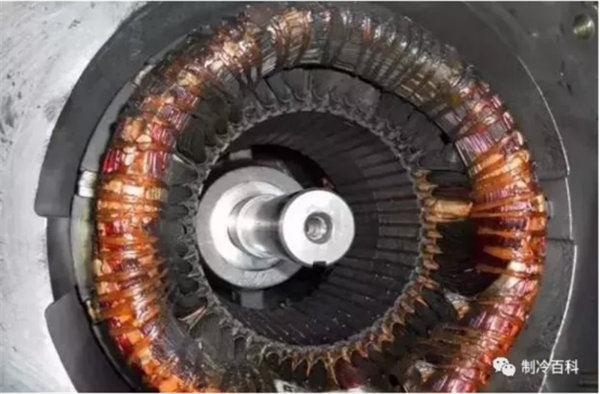
Common causes of compressor coil burning
1. The air conditioning compressor starts frequently
In the process of starting the air conditioning compressor, a step-down starting circuit is generally set, but the starting current will exceed several times of the rated current, and the starting temperature of the air conditioning compressor motor rises very fast. If the air conditioner temperature is not set properly, the refrigeration temperature is too low and the heating temperature is too high, the air conditioning compressor will be turned on and off frequently, which will shorten the service life of the air conditioning compressor.
2. The air conditioning compressor starts frequently
Poor power supply voltage quality, such as too high or too low voltage, will have a negative impact on the motor of the air conditioning compressor, especially if it is used beyond the rated voltage range of the air conditioning compressor. Long term operation will make the motor of the air conditioning compressor in an inefficient and overheated state, resulting in poor insulation and burning of the motor winding. In addition, the three-phase voltage or current imbalance will also increase the motor loss (iron loss and copper loss), the motor coil temperature of the air conditioning compressor is too high, the superheater protection is improper, and the insulation of the air conditioning compressor motor is burned, resulting in the short circuit of the air conditioning motor coil.
3. The refrigeration system was not cleaned up after the compressor was burnt out
For the air conditioning and refrigeration system with compressor burning fault, the refrigeration system must be cleaned thoroughly. When the air conditioning compressor motor is burned, strong acid will be generated and stay in the system. If it is not cleaned, when the new air conditioning compressor motor runs, the residual acid will corrode the insulation layer of the air conditioning compressor motor, resulting in the burning of the new air conditioning compressor.
4. Insufficient cleanliness of copper pipe system
It contains water, which will also lead to poor insulation of air conditioning compressor motor; Water, refrigerant and refrigeration oil circulate in the system. After changes in high temperature and low temperature, acidic substances will be produced, which will damage the insulation layer of the motor. After a long working time, the motor of the air conditioning compressor will be burned.
5. Poor cooling of compressor
The return air temperature is too high or the return air volume is too low, resulting in insufficient cooling of the compressor motor coil. For air-cooled heat pump units, this happens more, and too high return air temperature will also lead to too high exhaust temperature, resulting in a series of air-conditioning compressor problems.
6. Compressor starting contactor failure
The contact resistance of the contactor is too large or sintered, resulting in short circuit and burning of the air conditioning compressor motor, or poor line contact and large starting current, which is easy to burn the air conditioning compressor.
7. Short circuit caused by metal chips
The metal chips mixed in the winding are the culprit of short circuit and low grounding insulation value. The normal vibration during the operation of the compressor and the twisting of the winding under the action of electromagnetic force during each startup will promote the relative movement and friction between the metal chips mixed between the windings and the winding enamelled wire. Sharp metal chips will scratch the insulating layer of enameled wire and cause short circuit.
-
2021-11-24
Comparison of R22, R410A, R32 and R290 refrigerants
Comparison of R22, R410A, R32 and R290 refrigerants
At present, the refrigerant widely used in household air conditioning and heat pump is R22, which belongs to ozone depleting substance HCFC. According to the Montreal Protocol, China will eliminate the production and consumption of all manufacturing HCFC by 2030 [1]. The alternative refrigerants for R22 can be roughly divided into three categories:
The first type is HFC refrigerant, such as R410A (widely used) and R32 (potential refrigerant);
The second type is HC hydrocarbon refrigerant, such as R290 (potential refrigerant);
The third category is natural working medium carbon dioxide CO2 - it is generally not used in household air conditioning due to its high working pressure.
At present, the focus of household air-conditioning refrigerants mainly focuses on R22, R410A, R32 and R290. As the media of refrigeration industry, it is necessary for us to popularize their safety.
The safety of refrigerants mainly includes toxicity and flammability. The national standard refrigerant numbering method and safety classification GB / T 7778-2017 divides the toxicity of refrigerants into class A (low chronic toxicity) and class B (high chronic toxicity), and divides the flammability into class 1 (no flame propagation), class 2L (weak possibility), class 2 (possibility) and class 3 (flammability and explosion). According to GB / T 778-2017, refrigerant safety is divided into 8 categories: A1, A2L, A2, A3, B1, B2L, B2 and B3, of which A1 is the safest and B3 is the most dangerous.

R22: refrigerant to be eliminated
R22 is composed of chlorodifluoromethane (CHCLF2), which is non combustible and non explosive, with low toxicity and safety grade of A1. R22 ozone depleting potential ODP > 0, so it is not suitable for long-term use, and China will completely eliminate it by 2030.
R410A: alternative refrigerant for R22
R410A is composed of R32 and R125 in the proportion of 50% by mass. Among them, R32 (difluoromethane, CH2F2, A2L), R125 (pentafluoroethane, cf3chf2, A1) and a410a are safety grade A1. They also belong to non combustion, non explosion and low toxicity working fluids.
Compared with R22, R410A belongs to high-pressure refrigerant, which has higher requirements for equipment and system pressure strength, but it is conducive to reducing compressor displacement, reducing heat exchange copper pipe diameter and saving raw materials; R410A has better heat transfer and flow characteristics than R22, which is conducive to improve the operation efficiency of air conditioning and has obvious energy-saving effect. At present, it has been widely used.
ODP of R410A = 0, no ozone consumption; However, the global warming potential of R410A is GWP = 1730 (as a comparison, GWP of CO2 = 1), which plays a great role in promoting global warming. Therefore, R410A is not the final environmental protection refrigerant solution.
R32: future refrigerant competitors
The chemical composition of R32 is difluoromethane CH2F2, which has low toxicity, slight combustion and safety grade of A2L. R32 has the possibility of explosion, and its explosion limit is 14.4% - 29.3% [3]. The problem of low flammability needs to be solved in the application of household air conditioning.
The refrigeration performance of R32 is close to that of R410A. Under the same refrigeration capacity, the filling capacity of R32 is less than R410A (about 30% reduction), but the exhaust temperature is higher than R410A. R32 has ODP = 0 and GWP = 675. It is a green refrigerant and an important substitute for R22. At present, it has been widely used in household air conditioners in Europe, America, Japan and other countries.
R290: future refrigerant competitors
The chemical composition of R290 is propane (ch3ch2ch3), with little toxicity and flammability, and the safety grade is A3. The explosion limit of R290 is 2.1% - 10.0% [3], and the explosion point is much lower than R32.
ODP = 0 and GWP = 20 of R290 have little effect on global warming. It belongs to natural organic matter and can be obtained directly from liquefied petroleum gas with low price. R290 has good thermal performance, large gasification latent heat and less liquid filling capacity of the system. Under the same working conditions, the exhaust temperature can be 20 ℃ lower than R22, which is conducive to prolonging the service life of the compressor.
Last year, R290 gradually entered the field of vision. Many domestic enterprises have established R290 air conditioning production lines, and the national environmental protection department is also sparing no effort to promote the marketization process of R290 products [4]. At present, domestic support for R290 is greater than R32.
The biggest obstacle to the popularization and application of R290 is flammability. During use, safety measures need to be increased to ensure that its filling amount is controlled within the specified value of relevant regulations (standard iec60335-2-24: 2007) - at present, R290 is safe and controllable when used in household air conditioners < 1.5p; In addition, the leakage shall be reduced and the ability of leakage detection and response shall be improved.
Reference:
Source: Jianhuan world
[1] China Ozone Layer Protection Action Network: Notice on submitting the letter of intent for HCFC elimination and transformation project in industrial and commercial refrigeration and air conditioning industry in 2013
[2] Numbering method and safety classification of refrigerants (GB / T 7778-2017)
[3] Shi Lin, Zhu Mingshan. Reanalysis of R32 replacing R22 in household / commercial air conditioners [J]. Journal of refrigeration, 2010,01:1-5
[4] China home appliance network: the first batch of R290 air conditioners in China were officially listed in Shenzhen
-
2022-02-25
R290 flammable R32 will explode? Talk about air conditioning refrigerants
R290 flammable R32 will explode? Talk about air conditioning refrigerants
Refrigerant, also known as refrigerant and refrigerant, also has another well-known name, called snow seed. We often say that adding snow and Freon is to add new refrigerant to the air conditioner.
The refrigerant we are most familiar with is Freon. In our impression, freon is an environmentally friendly substance. If Freon leaks into the atmosphere, it will destroy the ozone layer of the atmosphere and form an ozone hole.
In fact, freon is not just a substance. Freon can be roughly divided into three categories, including chlorofluorohydrocarbons, hydrochlorofluorocarbons and hydrofluorocarbons. What will break the ozone layer is actually chlorofluorohydrocarbons in freon, and it is not fluorine that destroys ozone, but chlorine.
Although hydrochlorofluorocarbons also contain chlorine, their damage to the ozone layer is much lower than that of hydrochlorofluorocarbons. Hydrofluorocarbons have almost zero damage to the ozone layer because they do not contain chlorine. In addition, freon is also a greenhouse gas. Although the concentration of freon in the atmosphere is significantly lower than that of other greenhouse gases, its greenhouse effect is 3400 ~ 15000 times that of carbon dioxide.
Therefore, refrigerants usually introduce ozone layer destruction potential value (ODP) and global warming coefficient value (GWP) to measure their impact on the environment. The lower the ODP and GWP values are, the more environmentally friendly they are.
1. R22 refrigerant
R22 refrigerant belongs to hydrochlorofluorocarbons, and its chemical name is difluoro monochloromethane. R22 refrigerant is one of the most used refrigerants in the past. Most of our old air conditioners may use R22 refrigerant.
However, the ozone layer destruction potential (ODP) of R22 refrigerant is 0.05 and the global warming coefficient (GWP) is 1700, which will not only destroy the ozone layer, but also aggravate the greenhouse effect. For environmental reasons, R22 refrigerant is being phased out. According to the Montreal agreement, China is also phasing out products using R22 refrigerant, which only exists in some fixed frequency air conditioners.
2. R410A refrigerant
R410A refrigerant is a substitute of R22 refrigerant and is the most used refrigerant on the market. R410A refrigerant is a mixed refrigerant, which is a mixture of R32 (difluoromethane) and R125 (pentafluoroethane). The two substances are mixed in the ratio of 1:1.
As a substitute for R22 refrigerant, R410A has an ozone layer destruction potential (ODP) of 0 and will not destroy the ozone layer. However, the global warming coefficient (GWP) of R410A is 2025. Many people say R410A is an environmentally friendly refrigerant, but it is not! Although R410A does not destroy the ozone layer, it will produce greenhouse gases, and the greenhouse gas effect even partially exceeds R22.
R410A refrigerant is a mixture of two substances in a certain proportion. In case of leakage, the manufacturer recommends refilling, so as to ensure that the mixing proportion of the two substances is consistent.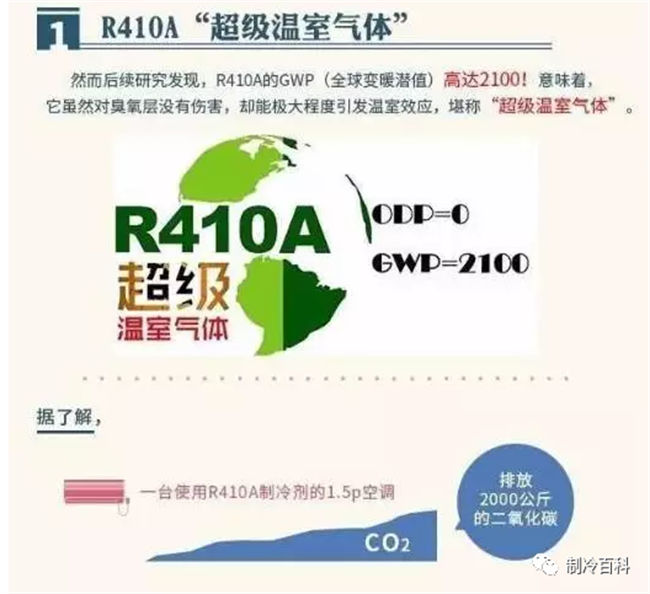
3. R32 refrigerant
R32 refrigerant belongs to hydrofluorocarbons and its chemical name is difluoromethane. The ozone layer destruction potential (ODP) of R32 refrigerant is 0 as that of R410A, while the global warming coefficient (GWP) of R32 is only 675, which is far lower than that of R410A.
In addition, R32 refrigerant has higher performance, less injection volume and lower cost than R410A. Moreover, R32's working pressure and performance parameters are close to R410A, and its maintenance and installation are basically the same. Adding fluorine again is the same as that of R22. You can add as much as you need, and you don't need to empty it all and refill it again.
However, R32 has a disadvantage, that is, it is combustible, and the combustion grade is A2. This is undoubtedly the biggest stumbling block to the promotion of R32 refrigerant.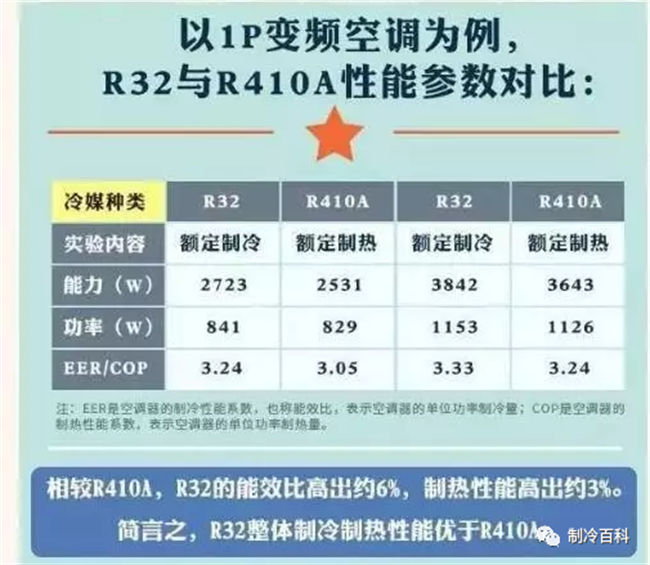
4. R290 refrigerant
R290 refrigerant is a more efficient and environmentally friendly refrigerant than R32 refrigerant. R290 does not belong to freon. Its chemical name is propane. Yes, it is the propane widely existing in natural gas. The ozone layer destruction potential (ODP) of R290 refrigerant is also zero, and its global warming coefficient (GWP) is very low, only 3.
It can be said that R290 refrigerant is the air conditioning refrigerant with the best environmental protection performance at present. However, R290 refrigerant is more flammable than R32, and its flammability is brought to grade A3. This puts forward higher requirements for all parts of the air conditioner, and it is required that the air conditioner can only be filled within 2p, and the air conditioner with large P number is limited. Therefore, this refrigerant has not been popularized at present. It is rumored in China that some manufacturers use R290 refrigerant for air conditioning products. It seems that some air conditioning products in Europe next door also use this refrigerant.
From the perspective of environmental protection, R32 and R290 refrigerants may be the most suitable refrigerants at present, but they are flammable and explosive! Some friends said, "environmental protection has nothing to do with me. I only care about safety."
Is that true? Let's look at the harm of excessive carbon emissions. Excessive carbon emissions will lead to global warming, produce greenhouse effect, accelerate the melting of ice and snow in the South and north poles, and cause the sea level to rise year by year; Cause extreme weather, such as typhoon, high temperature, rainstorm, debris flow, drought and other natural disasters; As a result, the temperature will rise, insect disasters will appear in some areas, the global food production may be seriously affected, and the output will gradually decline; The increase of carbon emissions will endanger people's health and quality of life. Who can survive the climate disaster?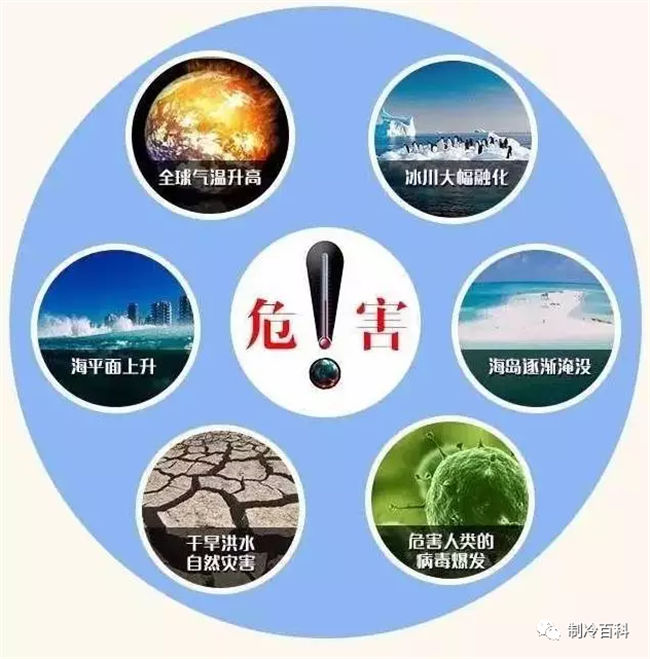
As mentioned earlier, R32 refrigerant belongs to combustible substances. If combustible substances leak and encounter open fire, they will explode. At present, too many R32 air conditioning explosion accidents have been reported in the news. This undoubtedly makes consumers worried and afraid of R32 air conditioner, which has brought great obstacles to the renewal of air conditioning refrigerant.
R32 refrigerant is combustible. Combustion conditions: the concentration needs to reach a certain value and encounter open fire. The emergence of R32 air conditioner undoubtedly puts forward more standardized operation for air conditioner installers.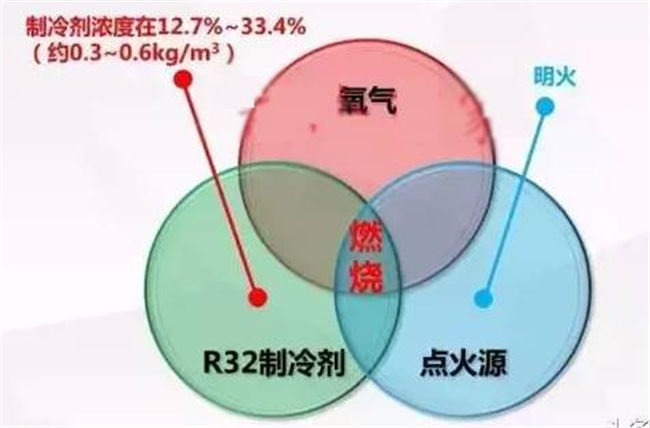
When installing the air conditioner, the length of the connecting pipe may be insufficient and the pipe needs to be lengthened. This situation is the most prone to problems and needs the most attention. First of all, the copper pipe should be lengthened, and the copper pipe needs to be reamed first. This step must be operated with a special pipe expander, and the hole must not be reamed with pointed nose pliers, so it is very easy to break and leak the copper pipe.
Another most important thing is the refrigerant leakage detection. Here, the refrigerant leakage detection steps in the Midea air conditioning manual are intercepted.
R32 product application precautions
1. If the copper pipe needs to be lengthened, the thickened copper pipe with thickness ≥ 0.8mm shall be used;
2. Pay attention to the difference between the installation and wiring and the pipe diameter of R22 refrigerant;
3. The internal machine and connecting pipe must be vacuumized and pressure maintained to ensure that the system has no leakage
4. Emptying is not allowed to replace vacuumizing;
5. For the extended copper pipe, add refrigerant according to the situation:
When the connecting pipe is less than or equal to 8m, no additional refrigerant is required. If the connecting pipe is more than 8m (subject to the liquid pipe), the refrigerant shall be added every 1m on the basis of 5m. The electronic scale must be used for quantitative addition. It is not allowed to add it by feeling or according to current, pressure and other parameters.
Contact us
Tel:0570-2829813
Fax:0570-3088229
E-mail:zjbezl@zjbezl.com
P.C.:324012
Add:No.28 Zesheng Road,Nianli Industrial Functional Zone,Qujiang Zone,Quzhou City,Zhejiang Province,China





